July 2021: Gimp update for Mac 2 includes information on
Brushes and patterns
Colors exchange
Colors threshold
Grid options
Symmetry Painting
My last post, written prior to these updates, revisiting-gimp-in-knit-design
I lean toward experimentation as a way of learning and finding what steps work for me. These notes are not intended as full tutorials, they simply share some of my explorations. There now are excellent videos online, but the amount of information can be overwhelming and tends to work with many more colors and significantly higher resolution images than those usually suitable for knitting, where images are often binary and small scale. I add to these work-in-progress notes as I have time, so the information in them will evolve over time with editing and at times rethinking the process used.
June 2021 I have been making a more concerted effort to use the latest version, though if one chooses to, files may still be opened with the earlier  There may be some differences in the program’s appearance depending on which version of Gimp, Mac computer, or OS is being used. Tools appear in new placements as well as the single-pixel brush/ pencil now that brushes fall into 4 types.
There may be some differences in the program’s appearance depending on which version of Gimp, Mac computer, or OS is being used. Tools appear in new placements as well as the single-pixel brush/ pencil now that brushes fall into 4 types.  The symmetry tool is greatly improved and more user-friendly, allowing the distribution of patterns in varied repeats across canvases ie garment pieces.
The symmetry tool is greatly improved and more user-friendly, allowing the distribution of patterns in varied repeats across canvases ie garment pieces.
January 2021 update GIMP 2.10.22: there seem to be very few changes. This could change slightly depending on the version of GIMP and Mac used.
Things to consider: the tools are now stacked in folders, shown on the right, so they are not immediately visible 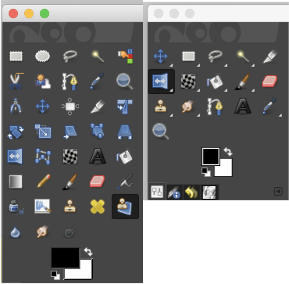 Right-click on the tool icon to reveal other choices
Right-click on the tool icon to reveal other choices  As they appear when viewed in their preferences folder
As they appear when viewed in their preferences folder  For changing the tool options to the more familiar format go to preferences, scroll down to and click on toolbox, uncheck use tool groups. That said, note that the placement of icons is different from the familiar older version format, ie. paint bucket and rectangle select.
For changing the tool options to the more familiar format go to preferences, scroll down to and click on toolbox, uncheck use tool groups. That said, note that the placement of icons is different from the familiar older version format, ie. paint bucket and rectangle select.  An option for selecting specific tools that include keyboard shortcuts to do so
An option for selecting specific tools that include keyboard shortcuts to do so  or right-click on the chosen tool
or right-click on the chosen tool  I had issues with the pencil tool not creating continuous lines, these are the settings that made that work for me, and they are saved when one quits the program
I had issues with the pencil tool not creating continuous lines, these are the settings that made that work for me, and they are saved when one quits the program  The jury is out as to whether changing the snapping preference value solves the problem long term
The jury is out as to whether changing the snapping preference value solves the problem long term A FB friend with a lot of experience with the program offered this as a possible cause “sometimes I accidentally activate commands with key combinations. It happens if you use the keyboard a lot (I have not used the mouse, for years). I work on a large Mac desktop and prefer the mouse to any keyboard commands.
A FB friend with a lot of experience with the program offered this as a possible cause “sometimes I accidentally activate commands with key combinations. It happens if you use the keyboard a lot (I have not used the mouse, for years). I work on a large Mac desktop and prefer the mouse to any keyboard commands.
The crop to selection tool when used on small files ie 20 pixels wide, crops to one extra pixel on the right, so to get a 15-pixel image, cropping to 14 wide appears to get the wanted result, checked with image/scale. The problem persists with slightly wider, and even tiled images up to 60 stitches wide 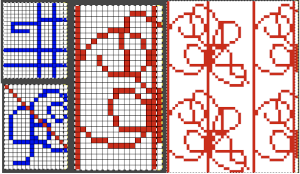
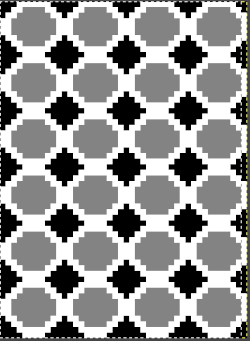 and here with a portrait size image
and here with a portrait size image 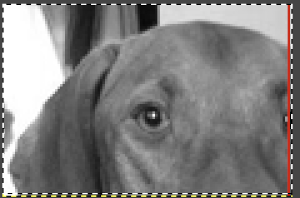 If brushes, colormaps, or palettes were saved in the “older” version, they will be lost. They can be recreated and saved using the brush import feature in the palette editor. Go to windows, dockable dialogue, palettes, and right-click on the palette window to call up the necessary menu choice
If brushes, colormaps, or palettes were saved in the “older” version, they will be lost. They can be recreated and saved using the brush import feature in the palette editor. Go to windows, dockable dialogue, palettes, and right-click on the palette window to call up the necessary menu choice  A new manual and program update for Mac OS are available (2.10.14 in 2020). The program launches in an all-in-one dark window with grey tool icons. As I become aware of any other changes I will attempt to share them. My use of the program is limited to working with imagery for knits and for my blog, my progress doing so up to now can be viewed via a category search. A lengthy tutorial on using 2.1 in Windows computers for beginners by Michael Davies was posted a year ago but new to me may be found on youtube.
A new manual and program update for Mac OS are available (2.10.14 in 2020). The program launches in an all-in-one dark window with grey tool icons. As I become aware of any other changes I will attempt to share them. My use of the program is limited to working with imagery for knits and for my blog, my progress doing so up to now can be viewed via a category search. A lengthy tutorial on using 2.1 in Windows computers for beginners by Michael Davies was posted a year ago but new to me may be found on youtube.
Mac users are included in the latest version update, but will need to get around security settings for installing software from non-Apple approved developers. Long-time users will face a very different appearance upon launching the program version 2.10, in a single window display 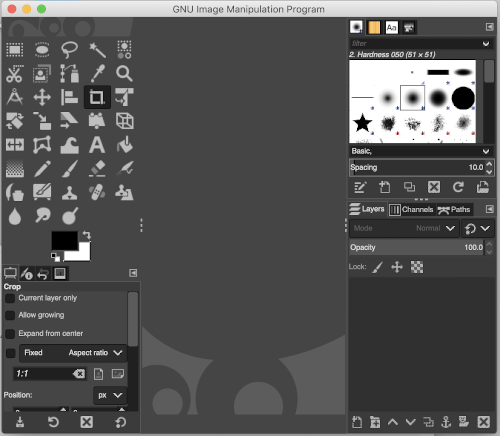 It is possible to switch to a lighter theme color by going to system preferences/ resources
It is possible to switch to a lighter theme color by going to system preferences/ resources 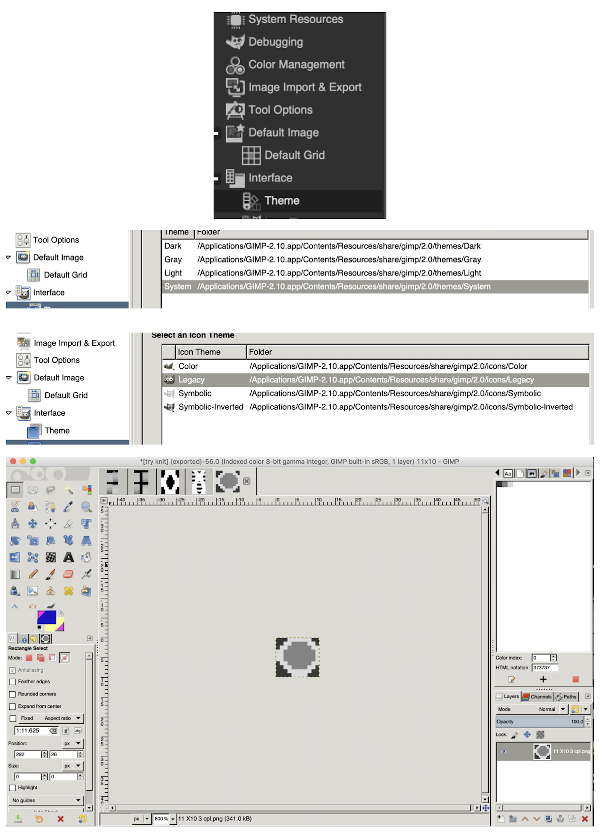 I actually found I have been working long enough in the dark theme to prefer it and restored it. These notes were taken when I first downloaded the program: images being processed appeared as shown below
I actually found I have been working long enough in the dark theme to prefer it and restored it. These notes were taken when I first downloaded the program: images being processed appeared as shown below  Previously clicking on the red X dot would ask if the image was to be discarded, and on the acknowledgment of the fact, the program would continue to stay open,
Previously clicking on the red X dot would ask if the image was to be discarded, and on the acknowledgment of the fact, the program would continue to stay open, 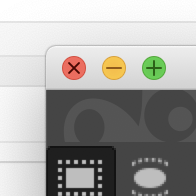 now that same action will quit the program completely. Clicking on the X beside the image will bring up the discard option, quitting the image and working on it as opposed to quitting the program. It is possible to work on multiple images at the same time. Drag and drop superimpose the new image fixed onto the center of first.
now that same action will quit the program completely. Clicking on the X beside the image will bring up the discard option, quitting the image and working on it as opposed to quitting the program. It is possible to work on multiple images at the same time. Drag and drop superimpose the new image fixed onto the center of first. 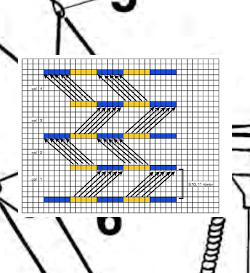 Choose file open,
Choose file open, 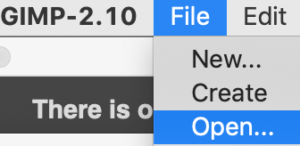 and processing multiple images is now available, with the ability to toggle between them.
and processing multiple images is now available, with the ability to toggle between them.  Working on 2 images again, copy the smaller image on its own screen,
Working on 2 images again, copy the smaller image on its own screen, 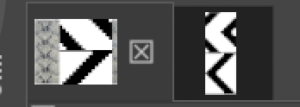 return to the screen with the larger image intended to be in the background, paste the smaller image for a floating selection that can be anchored anywhere on the ground, edit/ undo may be used repeatedly if need be, and done
return to the screen with the larger image intended to be in the background, paste the smaller image for a floating selection that can be anchored anywhere on the ground, edit/ undo may be used repeatedly if need be, and done

Discard each image individually to keep the program running, use the hide command if the larger update window is in your way or distracting, 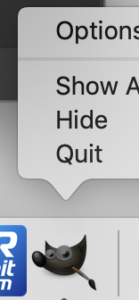 click on the gimp icon again to restore the view.
click on the gimp icon again to restore the view.
There is now an integrated search function
 2 sample entries:
2 sample entries:
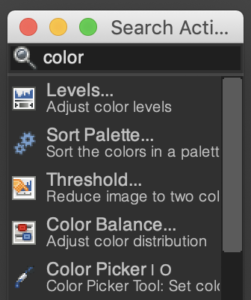
Document history can also be found on the right, 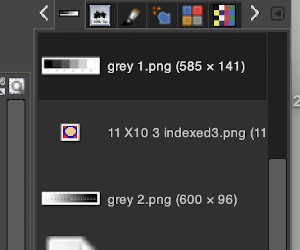 a right mouse click on any of the thumbnails will show possible document actions
a right mouse click on any of the thumbnails will show possible document actions 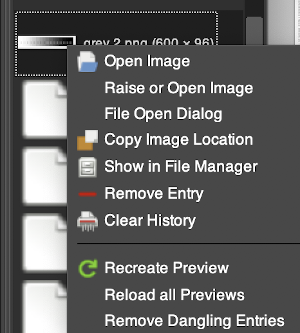
Experimenting with more changes to defaults: adjusted image size to start with. The default width and height are in full HD resolution. Setting @300 PPI is best for printing, and can be brought down for simple pixel work. The problem with doing that is that if a high-resolution image is then loaded into gimp, the result is not workable. I take photos of my swatches in high res, and scale them in GIMP prior to publishing them on my blog, the greyscale result at the bottom represents one such load for processing. 
Color settings may also be changed. Since Ayab and img2track do better with 8-bit integer color processing the new test defaults for me are shown below, which will mean only indexed images will have a colormap. Gamma changes automatically with bit adjustments, ie. a 32-bit color floating point will adjust to linear light gamma, which is the highest resolution possible.
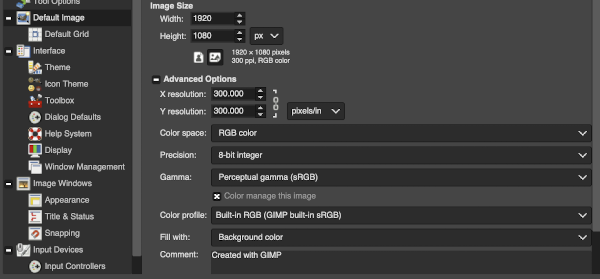 A word of caution: after choosing the 8-bit option and not liking the quality of my imported images, I tried restoring the original 32-bit floating one without success even after saving, quitting the program, and restarting it several times. I then chose to reinstall the program and continue working in the default settings for now. The download turned out to be for version 2.10.14, this is the new default appearance after launch on my computer
A word of caution: after choosing the 8-bit option and not liking the quality of my imported images, I tried restoring the original 32-bit floating one without success even after saving, quitting the program, and restarting it several times. I then chose to reinstall the program and continue working in the default settings for now. The download turned out to be for version 2.10.14, this is the new default appearance after launch on my computer
A new way to navigate menu options: a right mouse click in the workspace, once an image is loaded, will now make menu choices available within it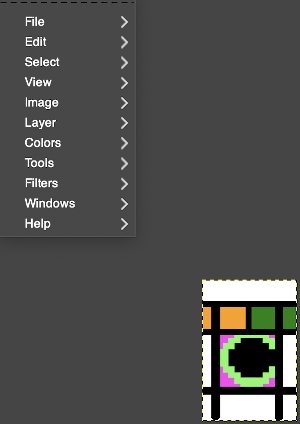
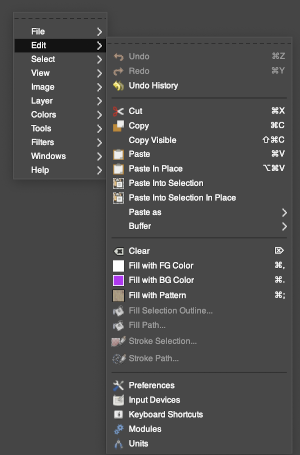
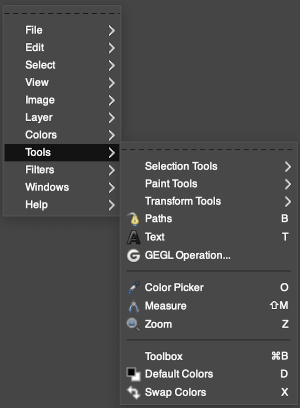
I use both Ayab and img2track, depending on the desired fabric outcome. There are active FB groups discussing the use of Gimp and both download programs as well as activity on Ravelry, where questions on tips and techniques become threads and have the great benefit of contributions by both Adrienne Hunter and Tanya Cunningham. Knowledge shared by both has rescued me from many sticky or problem spots in my own knitting.
In reference to Ayab, in one such thread on multiple colors per row knits, it was mentioned that color separations for 3 or more colors are done in shades of grey, and in terms of technical details “You need a pattern image which is 8-bit greyscale, each color is coded in a range of the 8bit values. So for 4 colors, it would be 0-63 color a; 64-127 color b; 128-195 color c; 196-255 color d. It seems to be OK to give the image some color, so long as the gray component of the colors divides up as given.”
As a matter of personal preference, I like to work with color in my repeats. The specific placement of each of the 3 (or more colors) can be planned in the color changer so that the yarn matches the corresponding color in the chart. That led to thinking about color numbers, shades of grey, and saving palettes.
Binary images have only 2 possible intensity values, normally displayed as black and white with values of either 1 or 255 for white, and often 0 for black. Thresholding a greyscale or colored image can be used to separate the image from the ground, the color object is often considered white, and the rest (black) is the ground. That convention may have led to the selection of white as color one in automatic separations such as the KRC Japanese one, where white is selected first. In a greyscale or color image, a pixel can take on any value between 0 and 255. Searching for numbers to match greyscale shades:

 Of note, the assigned numerical values are different depending on the source. The indexing options remain unchanged. These are results of reducing the number of colors used in each of the above. The results could be saved as .pngs, each of those opened, and the dropper tool used to select colors and use them in turn in new canvases where the motif is being designed.
Of note, the assigned numerical values are different depending on the source. The indexing options remain unchanged. These are results of reducing the number of colors used in each of the above. The results could be saved as .pngs, each of those opened, and the dropper tool used to select colors and use them in turn in new canvases where the motif is being designed.  What about saving the color information as easy access palettes? Doing so in this release is fairly intuitive.
What about saving the color information as easy access palettes? Doing so in this release is fairly intuitive.  The palette options include a Generate optimum palette for the best possible palette with a default maximum number of 256 colors (classic GIF format). You can reduce this Maximum Number of Colors, although this may create unwanted effects (color banding) on smooth transitions. You may be able to lessen the unwanted effects by using dithering, in image processing, however, in most knitting patterns the color may be limited to 4 or under when working in multiple colors per row. Use custom palette: this button lets you select a custom palette from a list. The number of colors is indicated for each palette.
The palette options include a Generate optimum palette for the best possible palette with a default maximum number of 256 colors (classic GIF format). You can reduce this Maximum Number of Colors, although this may create unwanted effects (color banding) on smooth transitions. You may be able to lessen the unwanted effects by using dithering, in image processing, however, in most knitting patterns the color may be limited to 4 or under when working in multiple colors per row. Use custom palette: this button lets you select a custom palette from a list. The number of colors is indicated for each palette.
Useful information on the indexed palette and palette editor.
When attempting to create and export new palettes in order to make them available in the future, an error message may be received. A folder needs to be activated for the saves to occur.  Both options below the writable folder heading should be checked, the red dot will then turn to green. To make the necessary change: folders may be found in system preferences at the bottom of the default list
Both options below the writable folder heading should be checked, the red dot will then turn to green. To make the necessary change: folders may be found in system preferences at the bottom of the default list  Click on the + to the left of the icon to expand the view of the available choices
Click on the + to the left of the icon to expand the view of the available choices 
To import a new palette, select windows/dockable items/ palettes in the top menu or select the option after right mouse click in the work area  To obtain a 6-color palette in the grey range, I reduced a greyscale image to 6 indexed colors and then used the settings below for the import after right-clicking in the palette dialog and choosing import palette from the resulting menu.
To obtain a 6-color palette in the grey range, I reduced a greyscale image to 6 indexed colors and then used the settings below for the import after right-clicking in the palette dialog and choosing import palette from the resulting menu.  The opportunity is there for editing the palette, it is the first item in the palette’s dialogue. To use the palette double click on your chosen one, a new palette editor dialogue opens up
The opportunity is there for editing the palette, it is the first item in the palette’s dialogue. To use the palette double click on your chosen one, a new palette editor dialogue opens up 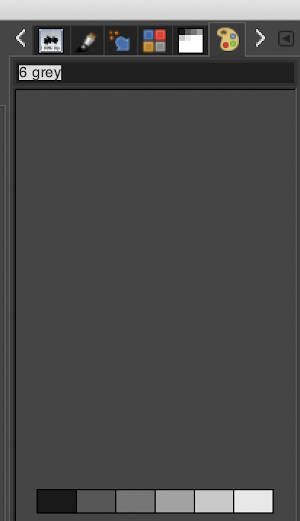 Selecting any one of the colors will automatically change the foreground color for working on the image ie choosing color 3 of the 6
Selecting any one of the colors will automatically change the foreground color for working on the image ie choosing color 3 of the 6 Switch the foreground and background-position and select an added color to make both of those 2 colors available while working
Switch the foreground and background-position and select an added color to make both of those 2 colors available while working 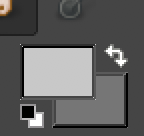 Using this feature with palettes containing multiple colors makes far quicker work when designing in RGB. Set pencil to desired pixel size, click on the desired color in any sequence to choose it, and then click again to place it on the working canvas
Using this feature with palettes containing multiple colors makes far quicker work when designing in RGB. Set pencil to desired pixel size, click on the desired color in any sequence to choose it, and then click again to place it on the working canvas 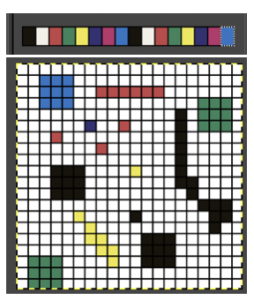 Right-click on any of the palette icons, for this dialogue menu
Right-click on any of the palette icons, for this dialogue menu  While experimenting I reached a point at which my pencil refused to draw in anything but gradient shades without my having changed any settings. The problem went away when I “found” the fade length and set it to 0. So much that is new, that it’s hard to know what is operator error and what may be a “bug”
While experimenting I reached a point at which my pencil refused to draw in anything but gradient shades without my having changed any settings. The problem went away when I “found” the fade length and set it to 0. So much that is new, that it’s hard to know what is operator error and what may be a “bug” 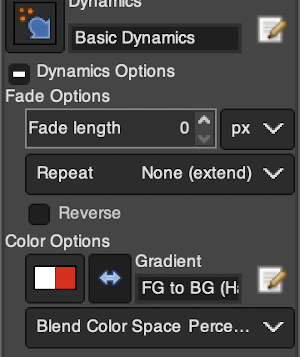 Another tool dialogue option to explore for ease in coloring pixels in specific palette colors
Another tool dialogue option to explore for ease in coloring pixels in specific palette colors 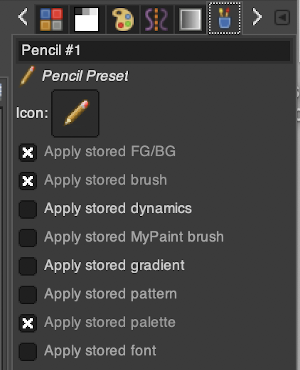 The Windows version of the software has had several small updates not available on the Mac yet. The latest was for 2.10.18 announced on 2-24-2020. As a result, searching for tutorials may provide instructions, views, and options not yet available to us, for example, transform dialogue in Windows
The Windows version of the software has had several small updates not available on the Mac yet. The latest was for 2.10.18 announced on 2-24-2020. As a result, searching for tutorials may provide instructions, views, and options not yet available to us, for example, transform dialogue in Windows 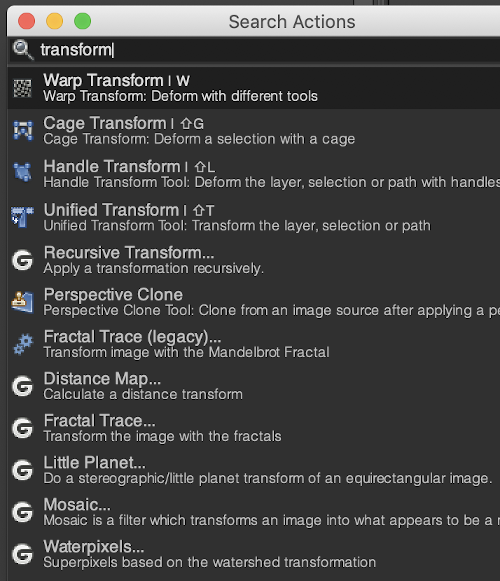 A sample in Mac, with the rotate dialogue which now appears as a separate window copied and pasted on the upper right of the image below
A sample in Mac, with the rotate dialogue which now appears as a separate window copied and pasted on the upper right of the image below 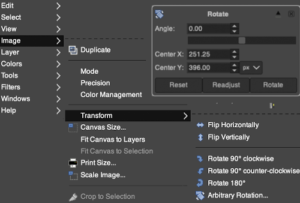 and another view from the image menu selection in the top dialogue
and another view from the image menu selection in the top dialogue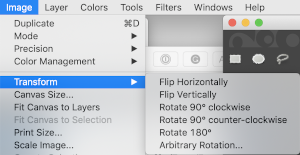 Symmetry is now an option for drawing in repeat in a variety of ways, making mirroring, tiling, and more possible while creating the design. The tool is considerably improved in version 2.10.22, see the post. My first experiments were on 40X40 files, magnified X800, with the grid in view. Some of the available choices:
Symmetry is now an option for drawing in repeat in a variety of ways, making mirroring, tiling, and more possible while creating the design. The tool is considerably improved in version 2.10.22, see the post. My first experiments were on 40X40 files, magnified X800, with the grid in view. Some of the available choices: 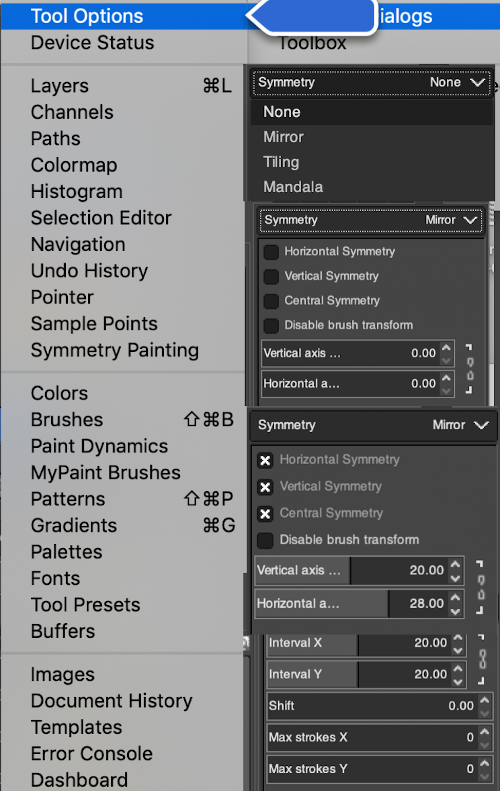 Some quick doodles using a single-pixel brush note the lags in some of the mirroring
Some quick doodles using a single-pixel brush note the lags in some of the mirroring
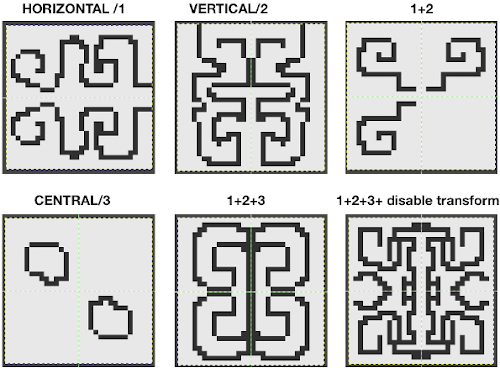 Other than drawing freehand I have had no luck working predictably with larger designs, even if saved as brushes or patterns. One problem is that the pivot point is 2 pixels in each direction, not one, so repeats with single stitches/rows along their center axis would still need editing. In a previous attempt to explain mirroring in a forum post, I used Passap 1273 as my sample pattern. Copying and pasting the image on a larger canvas leaves one unable to change the direction of the newly pasted image alone, the whole potential repeat is affected by the command. The image in question here was 16 pixels wide by 16 high, the goal to mirror it to a 32 by 32 repeat.
Other than drawing freehand I have had no luck working predictably with larger designs, even if saved as brushes or patterns. One problem is that the pivot point is 2 pixels in each direction, not one, so repeats with single stitches/rows along their center axis would still need editing. In a previous attempt to explain mirroring in a forum post, I used Passap 1273 as my sample pattern. Copying and pasting the image on a larger canvas leaves one unable to change the direction of the newly pasted image alone, the whole potential repeat is affected by the command. The image in question here was 16 pixels wide by 16 high, the goal to mirror it to a 32 by 32 repeat.
 There was no problem with transforming the original and pasting each in place, here it is also scaled twice as high and wide
There was no problem with transforming the original and pasting each in place, here it is also scaled twice as high and wide
 tiling is compared for both the original repeat and the same scaled X2, with both the final tiled images 128 pixels in width and height
tiling is compared for both the original repeat and the same scaled X2, with both the final tiled images 128 pixels in width and height  The best I could achieve with symmetry was a relative with 3 out of 4 motifs placed mirrored in the desired direction, but also off-center and in need of editing
The best I could achieve with symmetry was a relative with 3 out of 4 motifs placed mirrored in the desired direction, but also off-center and in need of editing 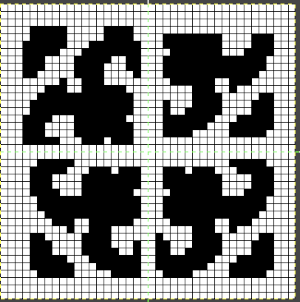 Freehand drawing the full repeat as given using symmetry is doable, but I found it a bit dizzying. Copy and paste around the central axis is not a solution. A compromise could be reached by freehand drawing for a different, final image that can be easy and immediate to produce. Some of the transitions:
Freehand drawing the full repeat as given using symmetry is doable, but I found it a bit dizzying. Copy and paste around the central axis is not a solution. A compromise could be reached by freehand drawing for a different, final image that can be easy and immediate to produce. Some of the transitions:  The mandala option reminds me of spirograph drawings, the number of points can easily be changed
The mandala option reminds me of spirograph drawings, the number of points can easily be changed 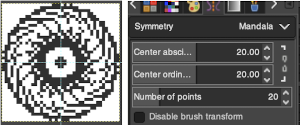 Tiling may be useful in brick or offset repeats, but my limited experiments did not produce anything worth saving or sharing.
Tiling may be useful in brick or offset repeats, but my limited experiments did not produce anything worth saving or sharing.
Text: any font installed on your computer can be made available by going to preferences once more, clicking on both options in the font folder, and green light on= you are set to go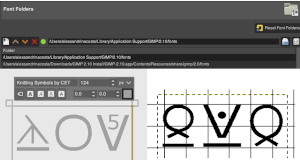 I have no idea yet whether symbols can be laid out on a custom grid so as to create a whole chart using them, but can imagine that large versions of symbols, web dings, and wingdings could potentially become pattern repeats. A very quick repeat from a webding 40 stitches wide
I have no idea yet whether symbols can be laid out on a custom grid so as to create a whole chart using them, but can imagine that large versions of symbols, web dings, and wingdings could potentially become pattern repeats. A very quick repeat from a webding 40 stitches wide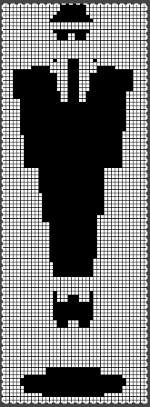
and a 24 stitch one 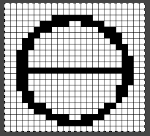
On 10/18 I ran into issues when using the pencil tool with the fore and background colors swapping positions during long strokes 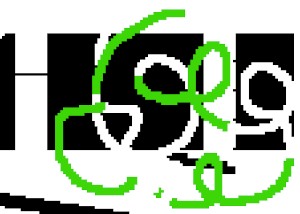 along with switching formats from 8-bit to 32 with pencil drawing seizures. Restarting the program did not help. What appears to have provided a solution up to now, was to use preferences to reset and save the defaults for tools
along with switching formats from 8-bit to 32 with pencil drawing seizures. Restarting the program did not help. What appears to have provided a solution up to now, was to use preferences to reset and save the defaults for tools  and the 8-bit precision option
and the 8-bit precision option 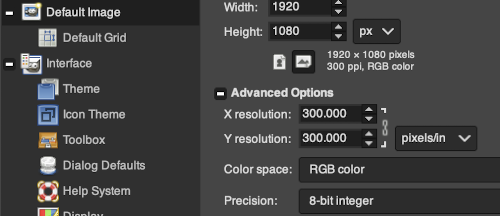 I have previously written on using Numbers (similarly done in Excel) to create charts, then importing them into Gimp to create .bmps for download. This is a review of a method that seems to work well with smaller repeats: the working chart. Make certain the table is formatted so that all cells are the same size, with equal height and width
I have previously written on using Numbers (similarly done in Excel) to create charts, then importing them into Gimp to create .bmps for download. This is a review of a method that seems to work well with smaller repeats: the working chart. Make certain the table is formatted so that all cells are the same size, with equal height and width 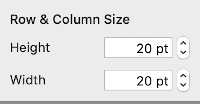
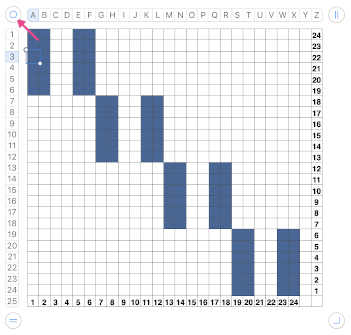 Use the border option to eliminate the interior cell borders, selecting no border,
Use the border option to eliminate the interior cell borders, selecting no border, 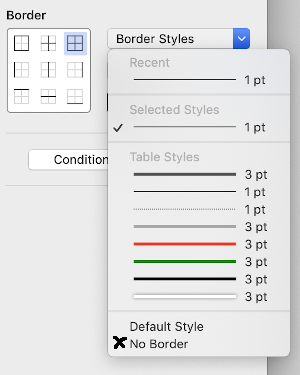
then add a border at the outer edges of the chart in a thin line,  screengrab the image with an additional white area surrounding it. The black outline below is from Gimp dark background
screengrab the image with an additional white area surrounding it. The black outline below is from Gimp dark background  Use the bucket fill tool to make each color segment black, change the mode to indexed,
Use the bucket fill tool to make each color segment black, change the mode to indexed, 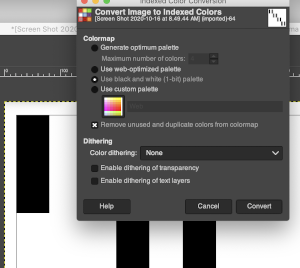 remove the excess border,
remove the excess border,  scale the image to the desired size,
scale the image to the desired size,  magnify to at least 800X, show grid, check that no clean up is needed,
magnify to at least 800X, show grid, check that no clean up is needed, 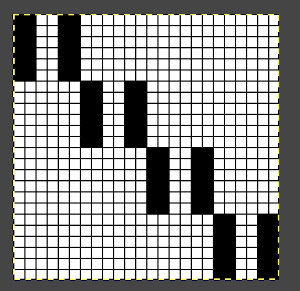 the image needs to be color reversed in order to be used for slip-stitch knitting,
the image needs to be color reversed in order to be used for slip-stitch knitting, 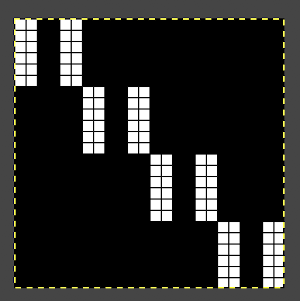 saved as an indexed .bmp
saved as an indexed .bmp If dragging and dropping or copying .bmps from FB or other sources, check that the download is still in indexed format and has not been altered to RGB mode during the process.
If dragging and dropping or copying .bmps from FB or other sources, check that the download is still in indexed format and has not been altered to RGB mode during the process.
A blog post illustrating using the repeat /2020/10/18/single-bed-tuck-mostly-slip-stitch-fabrics-3/
Subsequent posts:
Gimp to create text for knitting 1/21
Numbers and GIMP: online punchcard patterns to electronics 12/20
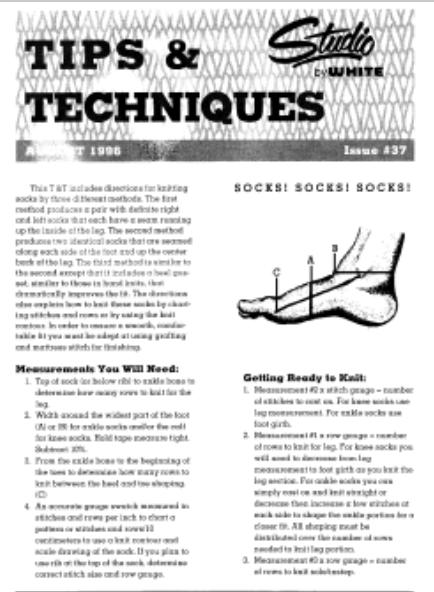 singer-sock-book-seamed-and-circular
singer-sock-book-seamed-and-circular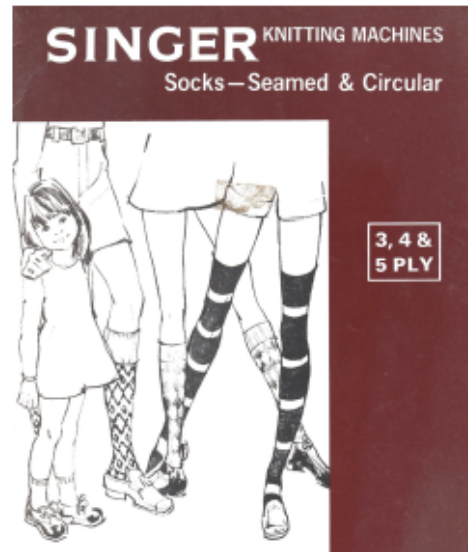 machine-knit-news-machine-knit-socks-supplement
machine-knit-news-machine-knit-socks-supplement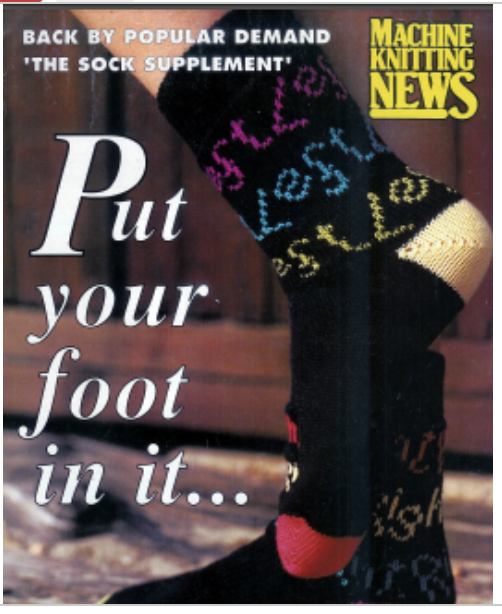 empisal-sock-patterns
empisal-sock-patterns
 Patterns from manufacturers: Superba manual
Patterns from manufacturers: Superba manual 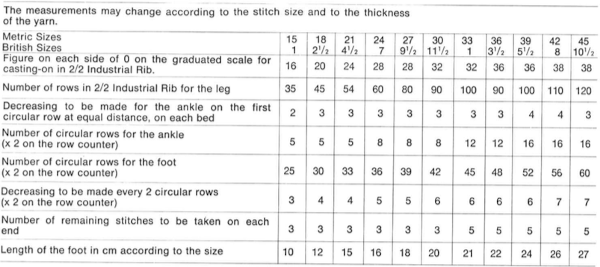
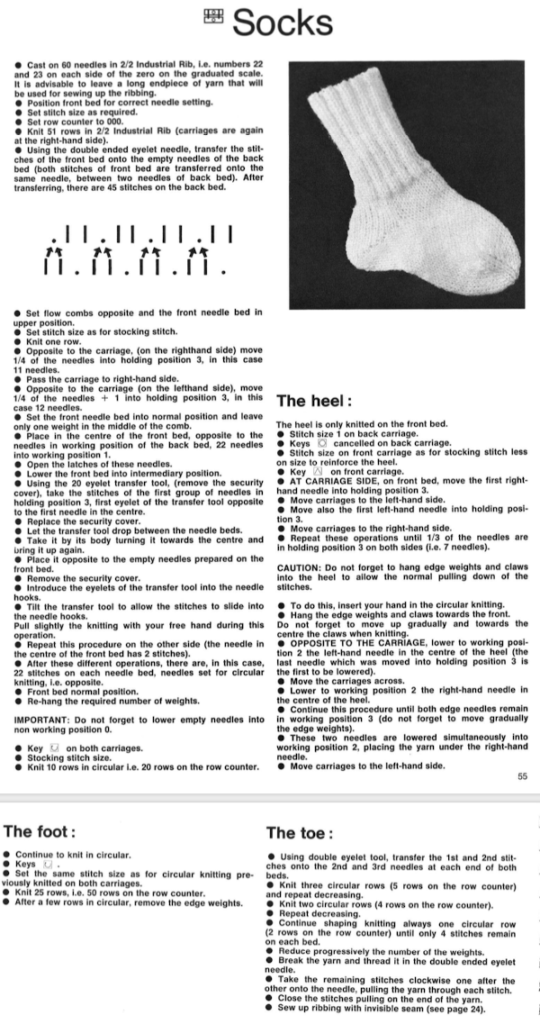 Passap Duo 80
Passap Duo 80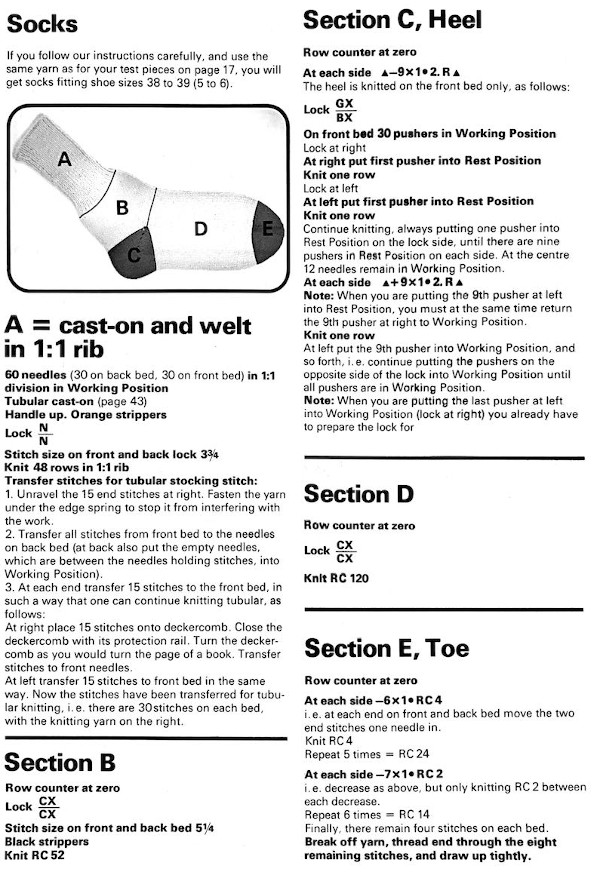 From a Brother pub. The original paper version actually came with knit leader patterns
From a Brother pub. The original paper version actually came with knit leader patterns
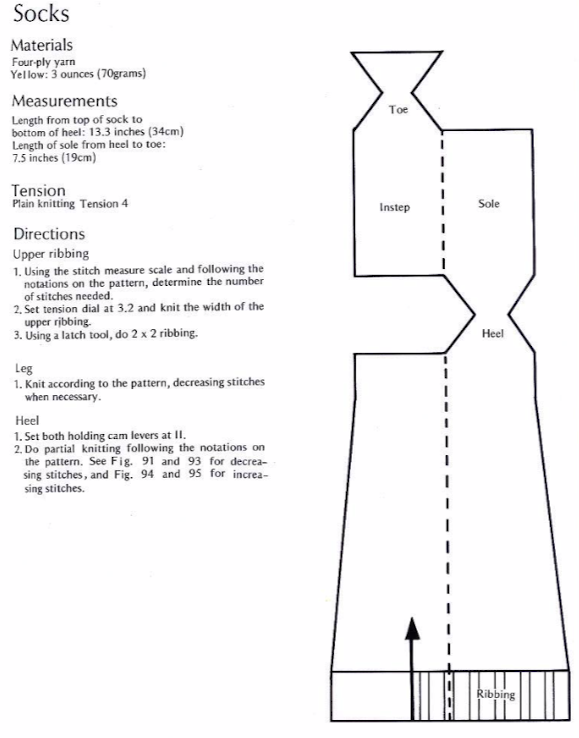
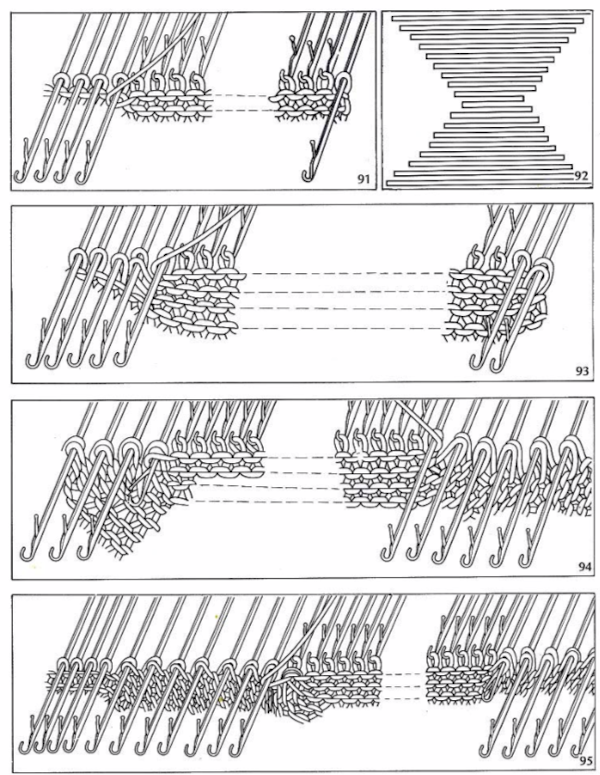
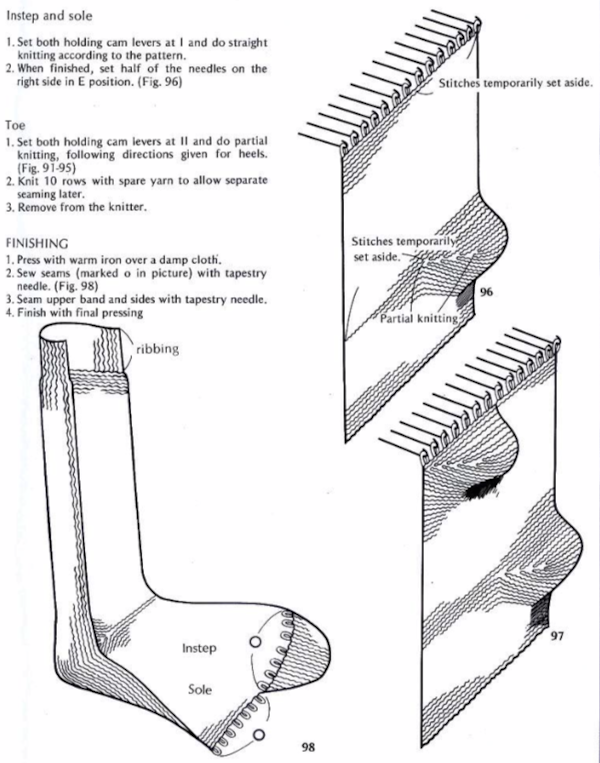
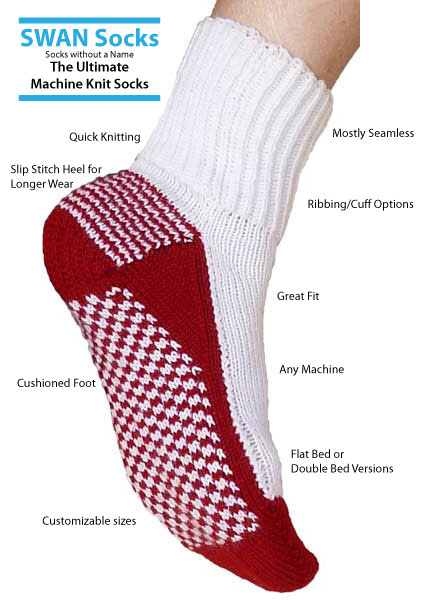 For advice and ideas on knitting the swan socks see https://knitterstoolchest.wordpress.com/category/circular-knitting/
For advice and ideas on knitting the swan socks see https://knitterstoolchest.wordpress.com/category/circular-knitting/ machine knit sock and slipper pattern resource
machine knit sock and slipper pattern resource on page 38 a repeat and instructions are offered for a spiral tube sock. The latter has no heel shaping, but traditional toe shaping can be added.
on page 38 a repeat and instructions are offered for a spiral tube sock. The latter has no heel shaping, but traditional toe shaping can be added.  The knit/purl design can easily be executed single bed by folks who own a G carriage. My mini sock was knit on 30 stitches +1 for sewing. The blocks can be varied in width depending on the required circumference of the finished tube. The extra pattern stitch in the chart is to allow for seaming a half stitch on each edge and maintaining the pattern. *After every 6 rows knit transfer the right-hand needle of every ribber group to the main bed, on the main bed transfer the right needle of every group down to the ribber**, repeat * to ** for the desired length. There are a number of ways to deal with the toe part of the stocking. I would opt for transferring stitches to the main bed and knitting one row, using holding remove half the width onto waste yarn then bringing half the stitches on the alternate side into work. The toes may then be worked using stocking stitch, scrapping off, and seaming or grafting the stitches held on scrap to each other. My working repeat, with a 12 stitch repeat usable on punchcard machines as well isolated by the added green border
The knit/purl design can easily be executed single bed by folks who own a G carriage. My mini sock was knit on 30 stitches +1 for sewing. The blocks can be varied in width depending on the required circumference of the finished tube. The extra pattern stitch in the chart is to allow for seaming a half stitch on each edge and maintaining the pattern. *After every 6 rows knit transfer the right-hand needle of every ribber group to the main bed, on the main bed transfer the right needle of every group down to the ribber**, repeat * to ** for the desired length. There are a number of ways to deal with the toe part of the stocking. I would opt for transferring stitches to the main bed and knitting one row, using holding remove half the width onto waste yarn then bringing half the stitches on the alternate side into work. The toes may then be worked using stocking stitch, scrapping off, and seaming or grafting the stitches held on scrap to each other. My working repeat, with a 12 stitch repeat usable on punchcard machines as well isolated by the added green border  testing the tiling, making certain any programming would line up
testing the tiling, making certain any programming would line up  Cast on for a ribbed band at top of the sock in any preferred configuration. Be certain cast on stretches enough to accommodate the finished width of the tube as it stretches to fit the leg. Transfer stitches between beds in the desired knit/purl configuration. When the desired height is reached transfer all stitches to the top bed, drop the ribber, switch sinker plates, knit a row on all stitches, divide for toe shaping. Here one half away from yarn end and carriage is knit with waste yarn and dropped off when shaping is complete,
Cast on for a ribbed band at top of the sock in any preferred configuration. Be certain cast on stretches enough to accommodate the finished width of the tube as it stretches to fit the leg. Transfer stitches between beds in the desired knit/purl configuration. When the desired height is reached transfer all stitches to the top bed, drop the ribber, switch sinker plates, knit a row on all stitches, divide for toe shaping. Here one half away from yarn end and carriage is knit with waste yarn and dropped off when shaping is complete, 
 After toe shaping is finished and waste yarn is added, the work is removed from the machine
After toe shaping is finished and waste yarn is added, the work is removed from the machine  Because all transfers are made in one direction, as in any knit fabric where that happens, the fabric will bias
Because all transfers are made in one direction, as in any knit fabric where that happens, the fabric will bias  Here the toe shaping is seamed, the twist in the body of the sock begins to show
Here the toe shaping is seamed, the twist in the body of the sock begins to show 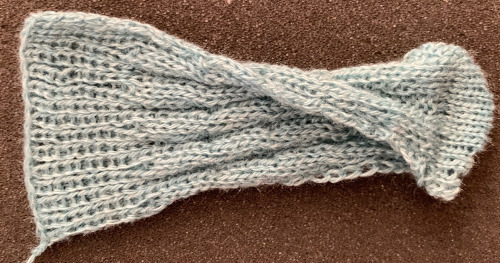 One side of my knitting was looser than the other, something to watch in any “real” piece. Thin yarn knit on tension 4 is probably also not the best suited for any socks in terms of wear. After seaming
One side of my knitting was looser than the other, something to watch in any “real” piece. Thin yarn knit on tension 4 is probably also not the best suited for any socks in terms of wear. After seaming  and worn by a few cotton balls 😉
and worn by a few cotton balls 😉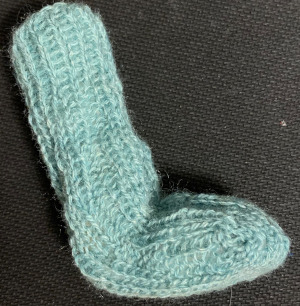 Lastly, it is possible to knit socks sideways (as well as gloves), usually in garter stitch and in hand knitting. This is a crochet illustration that points to the general construction method.
Lastly, it is possible to knit socks sideways (as well as gloves), usually in garter stitch and in hand knitting. This is a crochet illustration that points to the general construction method.

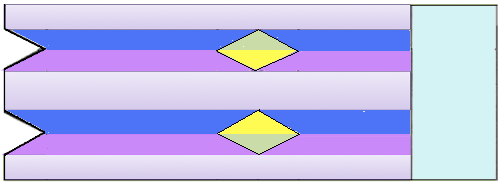 There would be at least one grafted seam the width of the sock, the cuff could be added with the side straight edge picked up and knit from there. To get shaping to match, in theory, one option would be to start with waste yarn, knit to half the above shape, scrap off. Rehang starting open stitches, reverse shaping, graft seam. Dotted lines represent open stitches, decreases and increases can be planned so that only the smaller group of stitches on one side are moved with a garter bar
There would be at least one grafted seam the width of the sock, the cuff could be added with the side straight edge picked up and knit from there. To get shaping to match, in theory, one option would be to start with waste yarn, knit to half the above shape, scrap off. Rehang starting open stitches, reverse shaping, graft seam. Dotted lines represent open stitches, decreases and increases can be planned so that only the smaller group of stitches on one side are moved with a garter bar 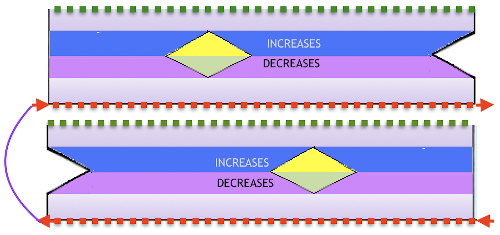
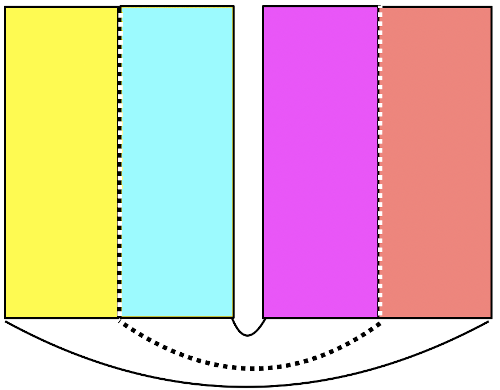

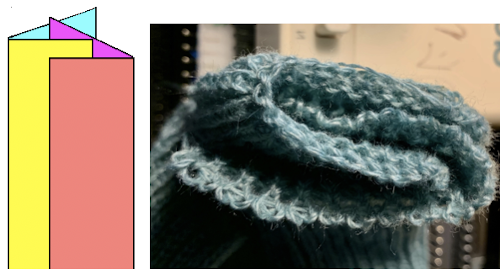


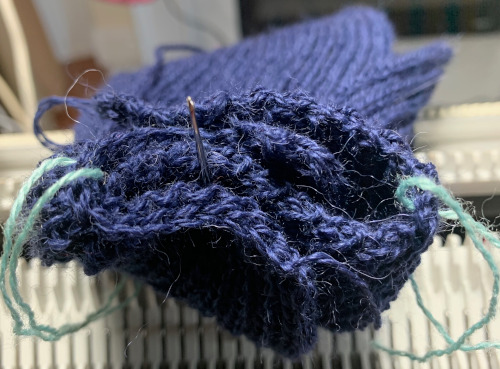

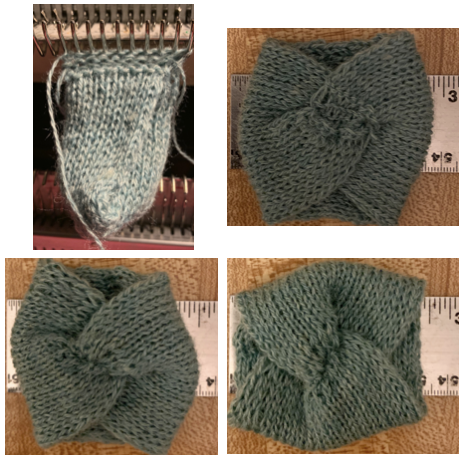 The elongated stitches at the top of the “band” are due to an extra needle in use on the ribber. To review, the proper settings from the Ribber Techniques Book:
The elongated stitches at the top of the “band” are due to an extra needle in use on the ribber. To review, the proper settings from the Ribber Techniques Book: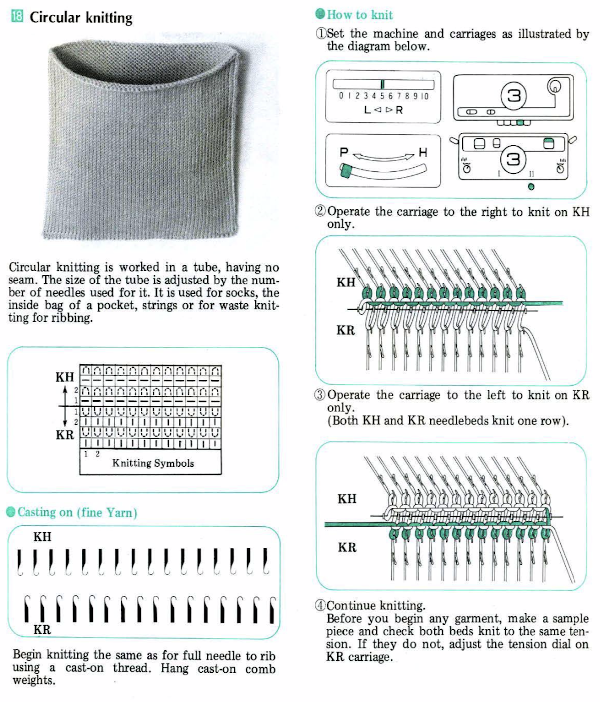
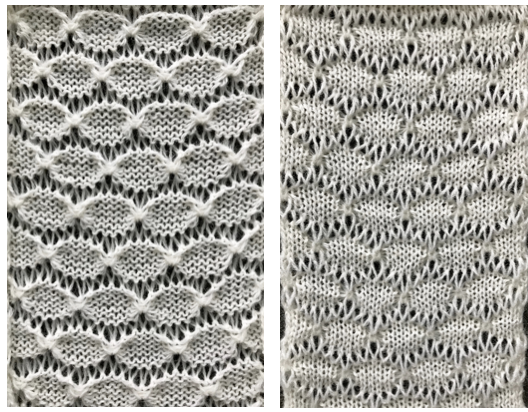 At about that time I came across this image on Pinterest.
At about that time I came across this image on Pinterest.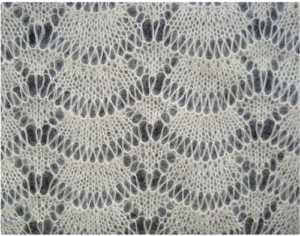 It combines transfer lace and long stitches, has characteristics that make some lace patterns unable to be reproduced on home knitting machines. Upon inspection, one will see that the number of stitches varies in different parts of the repeat. Aside from creating eyelets, the smaller triangular shapes increase in width, the fan shapes are decreased by half on their top row. Long stitches are created across all needles in work, then they are reconfigured so the center single stitch of the triangle and the center 2 stitches of the fan shape realign in the same position. The number of stitches at the start of the pattern and after the long stitches are created remains constant.
It combines transfer lace and long stitches, has characteristics that make some lace patterns unable to be reproduced on home knitting machines. Upon inspection, one will see that the number of stitches varies in different parts of the repeat. Aside from creating eyelets, the smaller triangular shapes increase in width, the fan shapes are decreased by half on their top row. Long stitches are created across all needles in work, then they are reconfigured so the center single stitch of the triangle and the center 2 stitches of the fan shape realign in the same position. The number of stitches at the start of the pattern and after the long stitches are created remains constant.  Trying variations on inspiration sources can lead to success, failure, somewhere in between, but also increase learning and skill that will carry over into other knitting techniques, even if the results are never used for a finished piece.
Trying variations on inspiration sources can lead to success, failure, somewhere in between, but also increase learning and skill that will carry over into other knitting techniques, even if the results are never used for a finished piece.


 I found making the transfers easier an the process more visible if I dropped one side of the ribber to the second, 17 mm. position
I found making the transfers easier an the process more visible if I dropped one side of the ribber to the second, 17 mm. position
 The ribber is set to N <– –> for three rows. On the first pass, all its needles will pick up the yarn, creating loops on every needle
The ribber is set to N <– –> for three rows. On the first pass, all its needles will pick up the yarn, creating loops on every needle
 With the ribber carriage alone, still set to N/N, free it, and make two passes to and from its starting side. The first pass releases the loops, the second returns it for coupling with the knit carriage. Below the long loops can be seen. My needle tape is “somewhere”, has not yet been returned to the ribber after my racking handle adventures were completed.
With the ribber carriage alone, still set to N/N, free it, and make two passes to and from its starting side. The first pass releases the loops, the second returns it for coupling with the knit carriage. Below the long loops can be seen. My needle tape is “somewhere”, has not yet been returned to the ribber after my racking handle adventures were completed. 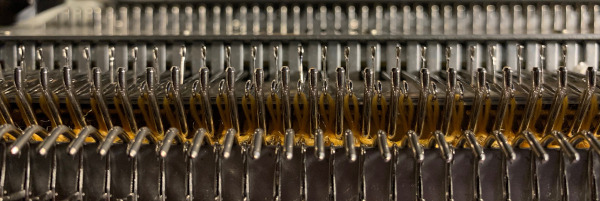 Return the ribber settings to slip in both directions, and repeat the process. Dropping the ribber to the lowest position at any point can verify goings-onHere one row has been knit on the main bed only, anchoring the loops, returning carriages to the opposite side prior to starting transfers once more
Return the ribber settings to slip in both directions, and repeat the process. Dropping the ribber to the lowest position at any point can verify goings-onHere one row has been knit on the main bed only, anchoring the loops, returning carriages to the opposite side prior to starting transfers once more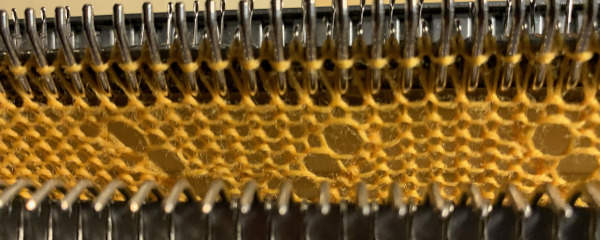 A word of caution: if loops are picked up on any single row that in theory was set to slip and was to be worked on only single bed, check to make certain the tuck lever has not been accidentally brought up to the tuck position. Although tuck <– –> can serve for a free pass on the main bed, having this setting on the ribber will create loops on all needles in work
A word of caution: if loops are picked up on any single row that in theory was set to slip and was to be worked on only single bed, check to make certain the tuck lever has not been accidentally brought up to the tuck position. Although tuck <– –> can serve for a free pass on the main bed, having this setting on the ribber will create loops on all needles in work 

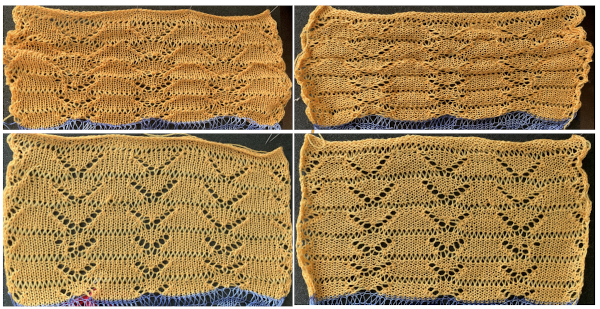
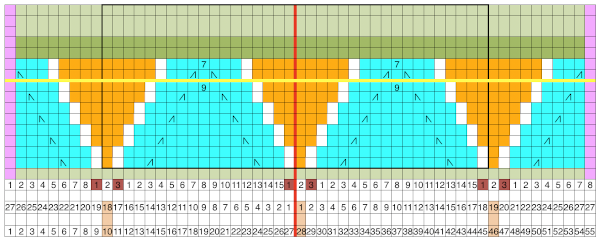 I cast on 55 stitches 27 left, 28 right. A ribber comb and weights are required.
I cast on 55 stitches 27 left, 28 right. A ribber comb and weights are required.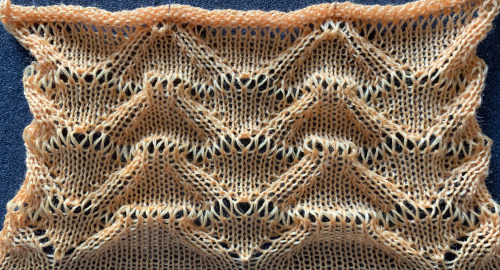
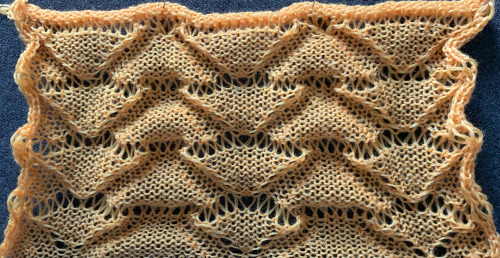
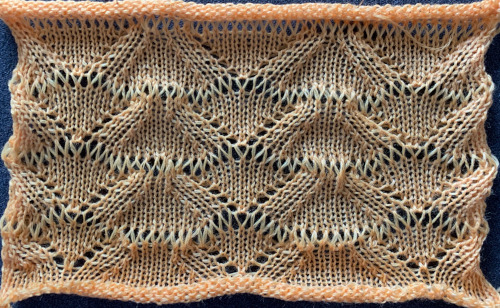
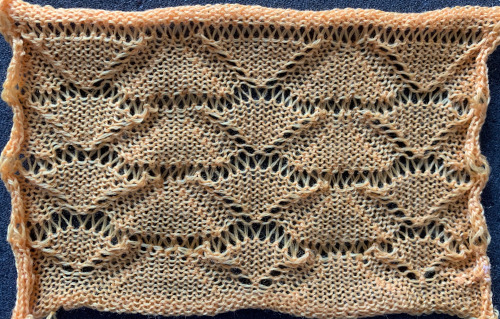
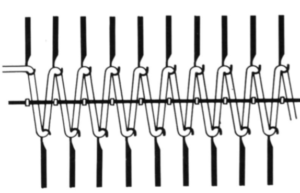


 The zig-zag will lean slightly to one side
The zig-zag will lean slightly to one side 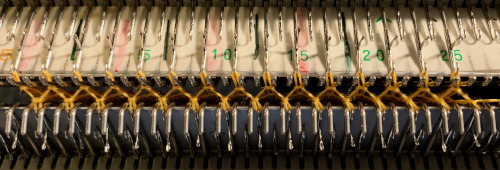


 If that is understood then one can make the choice of moving left or right and be off and running in the pattern, aside from the starting side or some of the other directions given in patterns or manuals. Cam buttons and patterning may be introduced as well. This is how a row of knitting might appear after racking.
If that is understood then one can make the choice of moving left or right and be off and running in the pattern, aside from the starting side or some of the other directions given in patterns or manuals. Cam buttons and patterning may be introduced as well. This is how a row of knitting might appear after racking. 
 This page from the Ribber Techniques book shows fabrics knit on EON, adding tuck cam buttons into the mix and slightly different needle arrangements, varying the look of the finished knitting.
This page from the Ribber Techniques book shows fabrics knit on EON, adding tuck cam buttons into the mix and slightly different needle arrangements, varying the look of the finished knitting. 
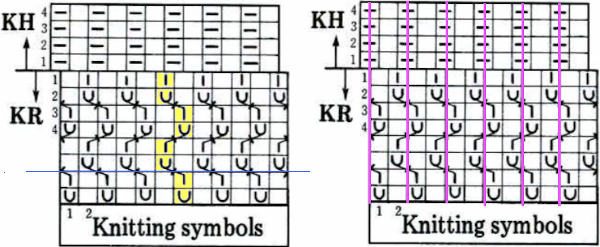 If multiple side-by-side stitches are in work on the ribber, the half-pitch setting applies as well. When tucking is added, for increased stretch, it may be necessary to compensate for the width of the resulting fabric by casting-on on every needle and then transferring in the desired configuration between the beds. Transferring is easier done in full pitch with a return to half-pitch prior to continuing to knit. The bind-off is likely to require considerations for an added stretch as well. Slip stitch narrows the fabric. Such adjustments are usually worked out in test swatches.
If multiple side-by-side stitches are in work on the ribber, the half-pitch setting applies as well. When tucking is added, for increased stretch, it may be necessary to compensate for the width of the resulting fabric by casting-on on every needle and then transferring in the desired configuration between the beds. Transferring is easier done in full pitch with a return to half-pitch prior to continuing to knit. The bind-off is likely to require considerations for an added stretch as well. Slip stitch narrows the fabric. Such adjustments are usually worked out in test swatches.
 By the way, the racking position indicators are slightly different in the Brother standard vs. the Brother bulky machines
By the way, the racking position indicators are slightly different in the Brother standard vs. the Brother bulky machines 
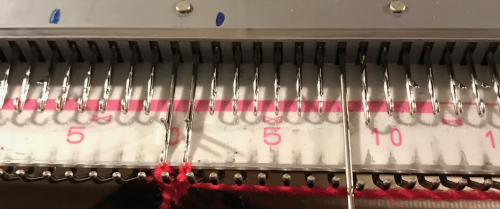

 e wrapping with second yarn before moving to left
e wrapping with second yarn before moving to left 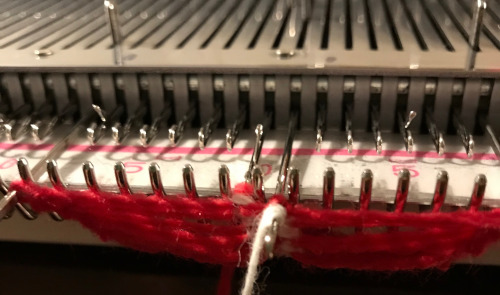 e wrapping with second yarn prior to returning to right, completing a sideways figure 8, end stitches out to E before prior to each carriage pass
e wrapping with second yarn prior to returning to right, completing a sideways figure 8, end stitches out to E before prior to each carriage pass 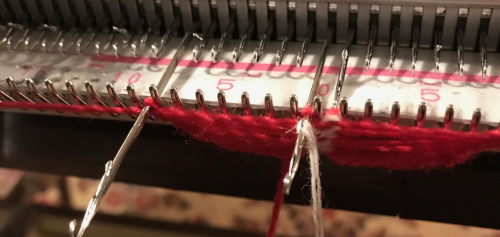 When the required number of rows has been knit, end COR. Unravel the first stitch on the right,
When the required number of rows has been knit, end COR. Unravel the first stitch on the right,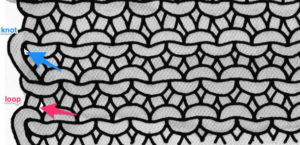
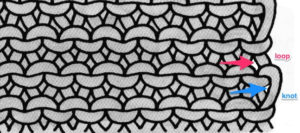 Using thinner yarn for knitting after the join even if on the same number of stitches, will gather the fabric
Using thinner yarn for knitting after the join even if on the same number of stitches, will gather the fabric 
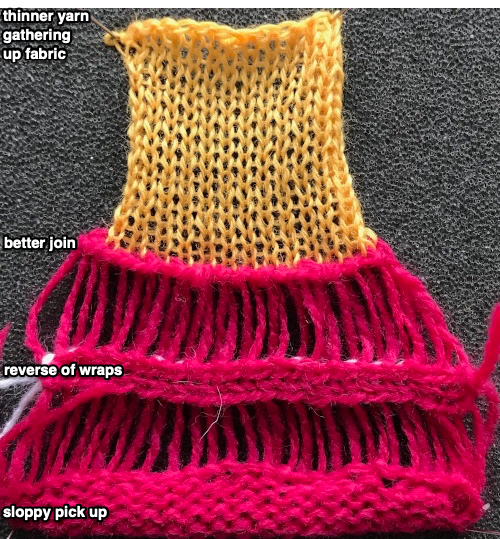 More on seaming and joining knits
More on seaming and joining knits  strips of different colors used
strips of different colors used 

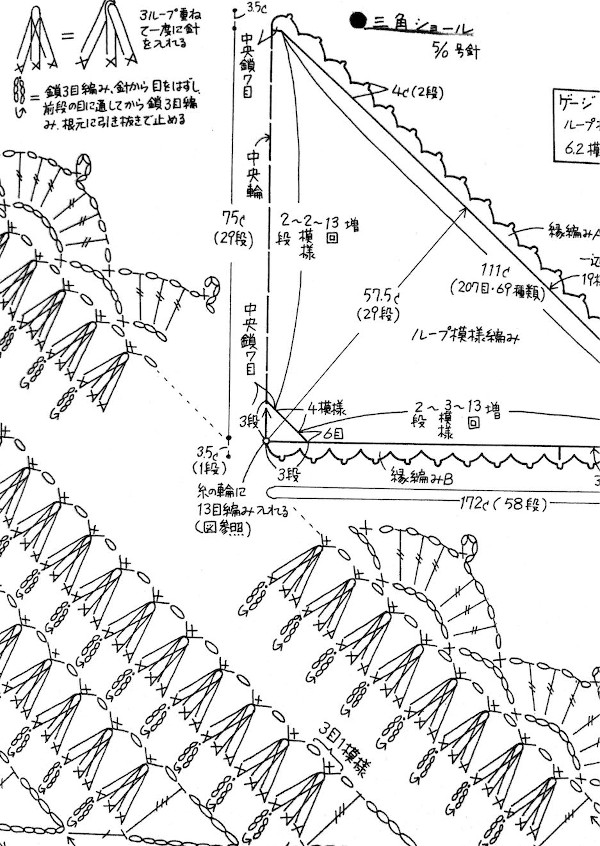 The convention for joining strips of machine knitting by crocheting or latching side loops together suggest having a ladder space (white square, one or more may be used) and a side edge stitch on either side in segments of the final piece ie. afghan strips.
The convention for joining strips of machine knitting by crocheting or latching side loops together suggest having a ladder space (white square, one or more may be used) and a side edge stitch on either side in segments of the final piece ie. afghan strips. 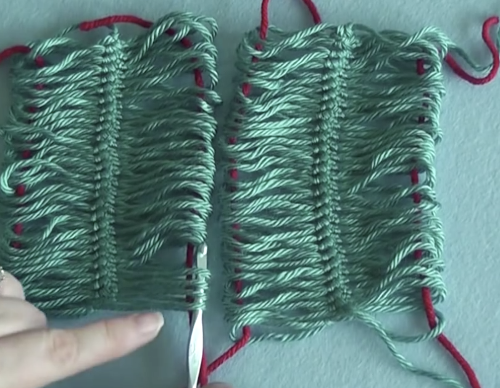
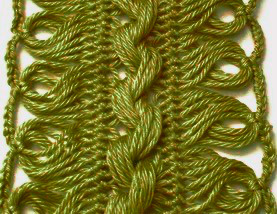 A partial illustration from Pinterest from an unknown source showing how the loops coming together to make shapes might be charted out: the ovals represent chain stitches, the v slip stitches, the different colors the finish of a complete strip’s edge
A partial illustration from Pinterest from an unknown source showing how the loops coming together to make shapes might be charted out: the ovals represent chain stitches, the v slip stitches, the different colors the finish of a complete strip’s edge  Tuck lace is a fabric produced with needles out of work in combination with tuck patterning on the main bed. Patterns for it can serve as the starting point for either the center strips in double-sided loop fabrics or they can be worked in repeats with wider ladder spaces between them for a far quicker “pretend” version. This is one of my ancient swatches for the technique from a classroom demo, using the 1X1 punchcard, shown sideways to save space.
Tuck lace is a fabric produced with needles out of work in combination with tuck patterning on the main bed. Patterns for it can serve as the starting point for either the center strips in double-sided loop fabrics or they can be worked in repeats with wider ladder spaces between them for a far quicker “pretend” version. This is one of my ancient swatches for the technique from a classroom demo, using the 1X1 punchcard, shown sideways to save space. The card is used at normal rotation. Any time there are needles out of work, end needle selection is canceled to maintain patterning throughout including on end needles of each vertical strip. Tuck <– –> is used resulting in texture as opposed to simple stocking stitch and ladder fabric (center of the swatch). In the right segment, the ladder threads are twisted, in the one on the left they are not. This is what is happening: for twisted ladders on an even total number of needles have an even number in the selected pattern (4), and an even number out of work (6). This is one fabric that definitely benefits from the use of some evenly distributed weight and a good condition sponge bar. End needle selection must be canceled
The card is used at normal rotation. Any time there are needles out of work, end needle selection is canceled to maintain patterning throughout including on end needles of each vertical strip. Tuck <– –> is used resulting in texture as opposed to simple stocking stitch and ladder fabric (center of the swatch). In the right segment, the ladder threads are twisted, in the one on the left they are not. This is what is happening: for twisted ladders on an even total number of needles have an even number in the selected pattern (4), and an even number out of work (6). This is one fabric that definitely benefits from the use of some evenly distributed weight and a good condition sponge bar. End needle selection must be canceled 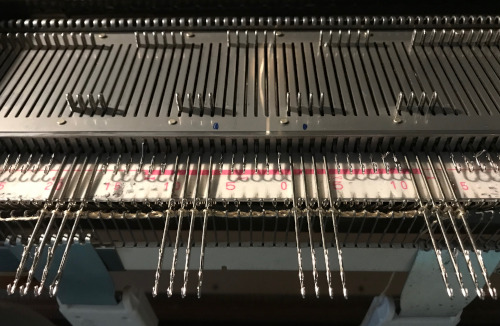
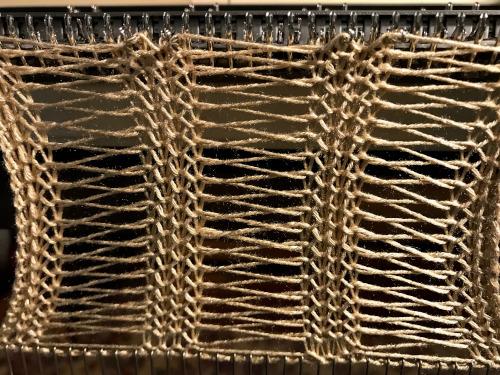 Here the stitches are arranged with an odd number in work (3), an odd number out of work (7)
Here the stitches are arranged with an odd number in work (3), an odd number out of work (7)
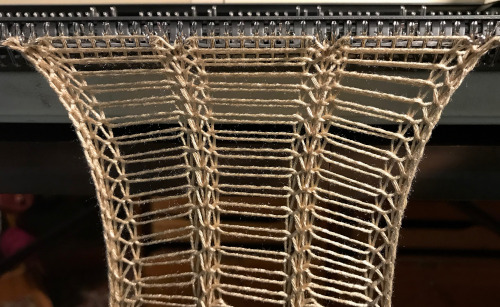

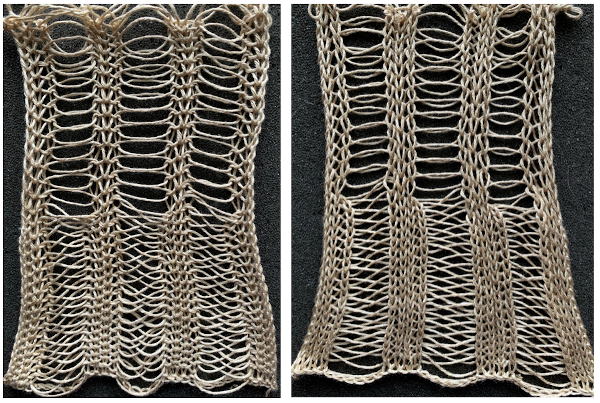

 The symmetry tool is greatly improved and more user-friendly, allowing the distribution of patterns in varied repeats across canvases ie garment pieces.
The symmetry tool is greatly improved and more user-friendly, allowing the distribution of patterns in varied repeats across canvases ie garment pieces. Right-click on the tool icon to reveal other choices
Right-click on the tool icon to reveal other choices 

 An option for selecting specific tools that include keyboard shortcuts to do so
An option for selecting specific tools that include keyboard shortcuts to do so  or right-click on the chosen tool
or right-click on the chosen tool 
 The jury is out as to whether changing the snapping preference value solves the problem long term
The jury is out as to whether changing the snapping preference value solves the problem long term A FB friend with a lot of experience with the program offered this as a possible cause “sometimes I accidentally activate commands with key combinations. It happens if you use the keyboard a lot (I have not used the mouse, for years). I work on a large Mac desktop and prefer the mouse to any keyboard commands.
A FB friend with a lot of experience with the program offered this as a possible cause “sometimes I accidentally activate commands with key combinations. It happens if you use the keyboard a lot (I have not used the mouse, for years). I work on a large Mac desktop and prefer the mouse to any keyboard commands. and here with a portrait size image
and here with a portrait size image 
 A new
A new 

 Previously clicking on the red X dot would ask if the image was to be discarded, and on the acknowledgment of the fact, the program would continue to stay open,
Previously clicking on the red X dot would ask if the image was to be discarded, and on the acknowledgment of the fact, the program would continue to stay open,  now that same action will quit the program completely. Clicking on the X beside the image will bring up the discard option, quitting the image and working on it as opposed to quitting the program. It is possible to work on multiple images at the same time. Drag and drop superimpose the new image fixed onto the center of first.
now that same action will quit the program completely. Clicking on the X beside the image will bring up the discard option, quitting the image and working on it as opposed to quitting the program. It is possible to work on multiple images at the same time. Drag and drop superimpose the new image fixed onto the center of first. 

 Working on 2 images again, copy the smaller image on its own screen,
Working on 2 images again, copy the smaller image on its own screen,  return to the screen with the larger image intended to be in the background, paste the smaller image for a floating selection that can be anchored anywhere on the ground, edit/ undo may be used repeatedly if need be, and done
return to the screen with the larger image intended to be in the background, paste the smaller image for a floating selection that can be anchored anywhere on the ground, edit/ undo may be used repeatedly if need be, and done
 click on the gimp icon again to restore the view.
click on the gimp icon again to restore the view.





 A word of caution: after choosing the 8-bit option and not liking the quality of my imported images, I tried restoring the original 32-bit floating one without success even after saving, quitting the program, and restarting it several times. I then chose to reinstall the program and continue working in the default settings for now. The download turned out to be for version 2.10.14, this is the new default appearance after launch on my computer
A word of caution: after choosing the 8-bit option and not liking the quality of my imported images, I tried restoring the original 32-bit floating one without success even after saving, quitting the program, and restarting it several times. I then chose to reinstall the program and continue working in the default settings for now. The download turned out to be for version 2.10.14, this is the new default appearance after launch on my computer





 What about saving the color information as easy access palettes? Doing so in this release is fairly intuitive.
What about saving the color information as easy access palettes? Doing so in this release is fairly intuitive. 





 Selecting any one of the colors will automatically change the foreground color for working on the image ie choosing color 3 of the 6
Selecting any one of the colors will automatically change the foreground color for working on the image ie choosing color 3 of the 6
 Using this feature with palettes containing multiple colors makes far quicker work when designing in RGB. Set pencil to desired pixel size, click on the desired color in any sequence to choose it, and then click again to place it on the working canvas
Using this feature with palettes containing multiple colors makes far quicker work when designing in RGB. Set pencil to desired pixel size, click on the desired color in any sequence to choose it, and then click again to place it on the working canvas  Right-click on any of the palette icons, for this dialogue menu
Right-click on any of the palette icons, for this dialogue menu 


 A sample in Mac, with the rotate dialogue which now appears as a separate window copied and pasted on the upper right of the image below
A sample in Mac, with the rotate dialogue which now appears as a separate window copied and pasted on the upper right of the image below  and another view from the image menu selection in the top dialogue
and another view from the image menu selection in the top dialogue
 Some quick doodles using a single-pixel brush note the lags in some of the mirroring
Some quick doodles using a single-pixel brush note the lags in some of the mirroring Other than drawing freehand I have had no luck working predictably with larger designs, even if saved as brushes or patterns. One problem is that the pivot point is 2 pixels in each direction, not one, so repeats with single stitches/rows along their center axis would still need editing. In a previous attempt to explain mirroring in a forum post, I used Passap 1273 as my sample pattern. Copying and pasting the image on a larger canvas leaves one unable to change the direction of the newly pasted image alone, the whole potential repeat is affected by the command. The image in question here was 16 pixels wide by 16 high, the goal to mirror it to a 32 by 32 repeat.
Other than drawing freehand I have had no luck working predictably with larger designs, even if saved as brushes or patterns. One problem is that the pivot point is 2 pixels in each direction, not one, so repeats with single stitches/rows along their center axis would still need editing. In a previous attempt to explain mirroring in a forum post, I used Passap 1273 as my sample pattern. Copying and pasting the image on a larger canvas leaves one unable to change the direction of the newly pasted image alone, the whole potential repeat is affected by the command. The image in question here was 16 pixels wide by 16 high, the goal to mirror it to a 32 by 32 repeat. There was no problem with transforming the original and pasting each in place, here it is also scaled twice as high and wide
There was no problem with transforming the original and pasting each in place, here it is also scaled twice as high and wide tiling is compared for both the original repeat and the same scaled X2, with both the final tiled images 128 pixels in width and height
tiling is compared for both the original repeat and the same scaled X2, with both the final tiled images 128 pixels in width and height 

 The mandala option reminds me of spirograph drawings, the number of points can easily be changed
The mandala option reminds me of spirograph drawings, the number of points can easily be changed  Tiling may be useful in brick or offset repeats, but my limited experiments did not produce anything worth saving or sharing.
Tiling may be useful in brick or offset repeats, but my limited experiments did not produce anything worth saving or sharing.



 and the 8-bit precision option
and the 8-bit precision option  I have previously written on using Numbers (similarly done in Excel) to create charts, then importing them into Gimp to create .bmps for download. This is a review of a method that seems to work well with smaller repeats: the working chart. Make certain the table is formatted so that all cells are the same size, with equal height and width
I have previously written on using Numbers (similarly done in Excel) to create charts, then importing them into Gimp to create .bmps for download. This is a review of a method that seems to work well with smaller repeats: the working chart. Make certain the table is formatted so that all cells are the same size, with equal height and width 
 Use the border option to eliminate the interior cell borders, selecting no border,
Use the border option to eliminate the interior cell borders, selecting no border, 

 Use the bucket fill tool to make each color segment black, change the mode to indexed,
Use the bucket fill tool to make each color segment black, change the mode to indexed, 

 magnify to at least 800X, show grid, check that no clean up is needed,
magnify to at least 800X, show grid, check that no clean up is needed,  the image needs to be color reversed in order to be used for slip-stitch knitting,
the image needs to be color reversed in order to be used for slip-stitch knitting, 
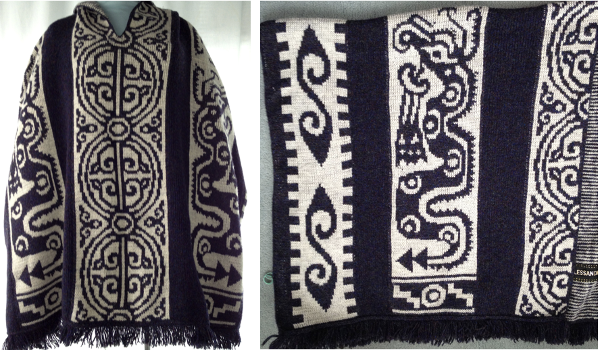
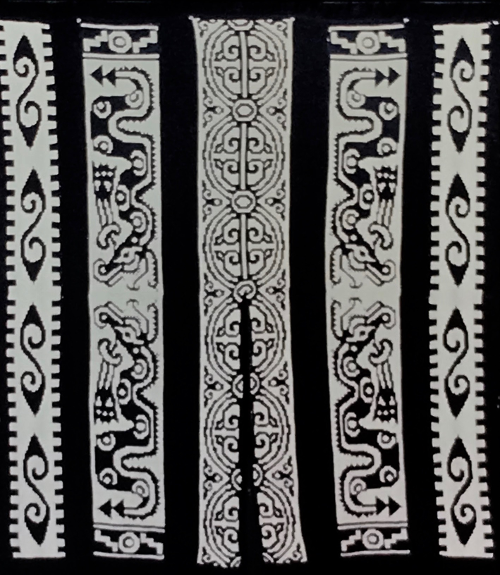 I made a few items with twisted strands inspired by those seen in wovens produced by my weaving friends. I have no photos of those, failed to document my work for quite a few years. One excuse was the quality of any photos I attempted, and even back in the day, professional photographers charged $180 an hour plus model fees if used. It seemed that adding the cost of such photography to limited edition runs that were planned for sale would make the wholesale price higher than the market would bear. We all make choices based on information we have at that particular time, which was long before the recent easy-to-use photo technology.
I made a few items with twisted strands inspired by those seen in wovens produced by my weaving friends. I have no photos of those, failed to document my work for quite a few years. One excuse was the quality of any photos I attempted, and even back in the day, professional photographers charged $180 an hour plus model fees if used. It seemed that adding the cost of such photography to limited edition runs that were planned for sale would make the wholesale price higher than the market would bear. We all make choices based on information we have at that particular time, which was long before the recent easy-to-use photo technology. Here a ladder space created by needles out of work is left between vertical fair isle repeats, producing a fringe in 2 colors. The design was not planned, a standard punchcard was used for the purpose of the demo. A planned repeat would have more impact. End needle selection is on, which is usual in FI, not for most patterns with either tuck or slip stitch settings combined with needles out of work, is also true here so that a vertical line on each side of the needles out of work between repeats aids in sewing the strips together. Width is limited since the fabric will be gathered by seaming and become significantly narrower and likely turned sideways. Both sides are shown. Joining could be planned to occur only at the bottom of a piece if desired, stitching lines will be less visible if thread color matches that of the yarn
Here a ladder space created by needles out of work is left between vertical fair isle repeats, producing a fringe in 2 colors. The design was not planned, a standard punchcard was used for the purpose of the demo. A planned repeat would have more impact. End needle selection is on, which is usual in FI, not for most patterns with either tuck or slip stitch settings combined with needles out of work, is also true here so that a vertical line on each side of the needles out of work between repeats aids in sewing the strips together. Width is limited since the fabric will be gathered by seaming and become significantly narrower and likely turned sideways. Both sides are shown. Joining could be planned to occur only at the bottom of a piece if desired, stitching lines will be less visible if thread color matches that of the yarn 
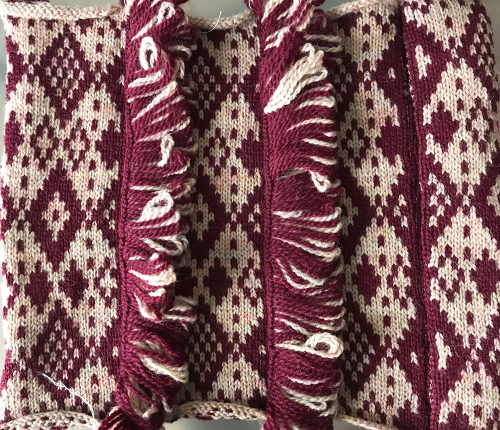 A needle in work away from the edge produces a side “fringe” followed here by felting partially, cutting the single edge stitch, and finishing the felting process
A needle in work away from the edge produces a side “fringe” followed here by felting partially, cutting the single edge stitch, and finishing the felting process Adding thicker or multiple strands of yarns in
Adding thicker or multiple strands of yarns in 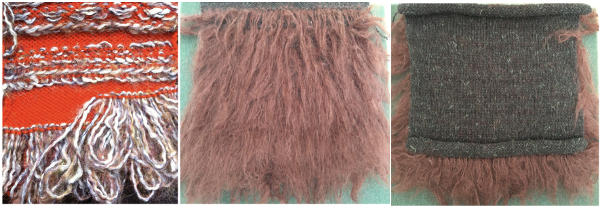
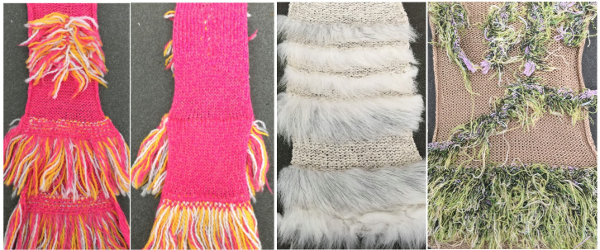
 Most often every other needle use is best. Here lace and pom trims are used, purchased fringes of all sorts could be applied the same way anywhere in the piece, joins to knit can be seen.
Most often every other needle use is best. Here lace and pom trims are used, purchased fringes of all sorts could be applied the same way anywhere in the piece, joins to knit can be seen. 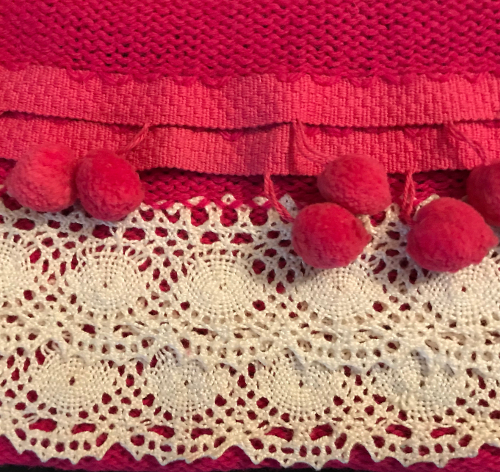 A length of roving may be twisted in its center and applied as you knit. For a while mittens using it as a lining for warmth were popular. A video by Carole Wurst shows a method used in socks
A length of roving may be twisted in its center and applied as you knit. For a while mittens using it as a lining for warmth were popular. A video by Carole Wurst shows a method used in socks 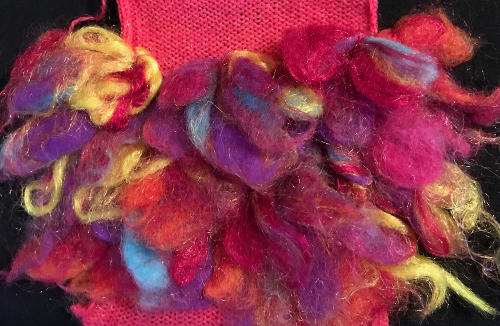

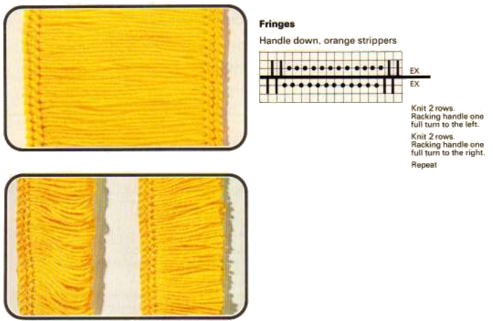 The thickness of the yarn chosen is of critical importance. When I first attempted to knit a version of it on my 930 I encountered problems. To start with, I kept dropping off the stitches on one side or the other. I checked the ribber alignment, proper placement of the cast on comb, switched ribbers, and carriages, and continued to have problems. After all that, the solution turned out to be simply adding another 4 stitches (2 on each bed) toward the center of the piece (I did not count). Here I used a 2/24 which obviously does not have enough body to use as an edging. The Brother equivalent for the Duo setting is half fisherman rib, where one carriage knits in one direction, tucks in the other on every needle for every 2 rows knit, while the other bed’s carriage does the same, but in opposite directions. I used 3 needles on each side rather than 2 as in the Duo repeat, starting with the first needle in work on the left on the ribber, the last needle in work on the right on the top bed. One may begin to knit on either side, but when manually setting the cam buttons lead with settings so that first stitch knits as it moves to the opposite side. Using waste yarn at the start of the piece will produce a better cast on edge for the trim. Operating from the right:
The thickness of the yarn chosen is of critical importance. When I first attempted to knit a version of it on my 930 I encountered problems. To start with, I kept dropping off the stitches on one side or the other. I checked the ribber alignment, proper placement of the cast on comb, switched ribbers, and carriages, and continued to have problems. After all that, the solution turned out to be simply adding another 4 stitches (2 on each bed) toward the center of the piece (I did not count). Here I used a 2/24 which obviously does not have enough body to use as an edging. The Brother equivalent for the Duo setting is half fisherman rib, where one carriage knits in one direction, tucks in the other on every needle for every 2 rows knit, while the other bed’s carriage does the same, but in opposite directions. I used 3 needles on each side rather than 2 as in the Duo repeat, starting with the first needle in work on the left on the ribber, the last needle in work on the right on the top bed. One may begin to knit on either side, but when manually setting the cam buttons lead with settings so that first stitch knits as it moves to the opposite side. Using waste yarn at the start of the piece will produce a better cast on edge for the trim. Operating from the right: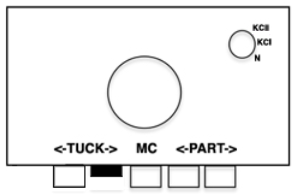

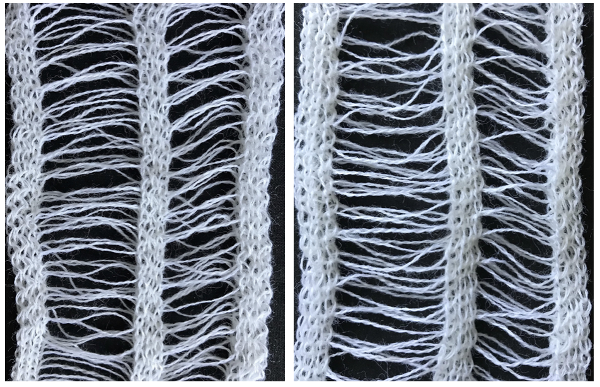 A 2/11.5 acrylic provided more of a tension adjustment challenge but made for a better fringe.
A 2/11.5 acrylic provided more of a tension adjustment challenge but made for a better fringe. The first and last 3 stitches on either side were transferred to the top bed and bound off, the center stitches were not, allowing them to be unraveled if desired ie in case the fringe is to be folded in half. Those extra center stitches also provide a guide for cutting either down their center (bottom of photo) or on either side of them (toward the top). I found the latter method to produce a cleaner cut line
The first and last 3 stitches on either side were transferred to the top bed and bound off, the center stitches were not, allowing them to be unraveled if desired ie in case the fringe is to be folded in half. Those extra center stitches also provide a guide for cutting either down their center (bottom of photo) or on either side of them (toward the top). I found the latter method to produce a cleaner cut line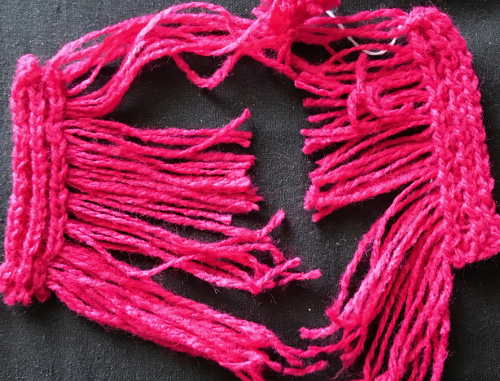 Suggestions for going wider with racked half fisherman rib on Japanese machines: begin with needle arrangement below, out of work needles can be as many as needed, set up and cast on with preferred racking position ie on 5, knit several rows in waste yarn making any adjustments needed so stitches knit are formed properly, weigh appropriately.
Suggestions for going wider with racked half fisherman rib on Japanese machines: begin with needle arrangement below, out of work needles can be as many as needed, set up and cast on with preferred racking position ie on 5, knit several rows in waste yarn making any adjustments needed so stitches knit are formed properly, weigh appropriately. 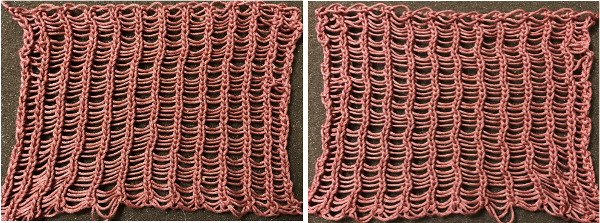 the edge that holds the fringe together is to be very narrow (or even added as one continues to knit) and one wishes to work on the single bed there are several options. With 4-ply and a “matching color” 2 ply I began with the top needle arrangement, and then switched to the one below it, knitting on a 4.5 mm machine.
the edge that holds the fringe together is to be very narrow (or even added as one continues to knit) and one wishes to work on the single bed there are several options. With 4-ply and a “matching color” 2 ply I began with the top needle arrangement, and then switched to the one below it, knitting on a 4.5 mm machine.  A permanent cast-on needs to take place in the preferred method over needles in work knit 2 rows. The stitch on the second needle from the left is going to want to stretch and tends not to be stable. To reduce that happening, there are 2 options involving the second strand of yarn. Here using a 2 ply helps serve that purpose and keeps the fringed strands closer together. The slower method is to remove the second stitch from the left on a tool after every 2 rows knit, then bring the separate yarn strand behind the now empty needle first from the right, then in turn from the left, returning the removed stitch to the machine, knitting 2 rows. I found that too slow for my patience, switched to just laying the second strand over needles before knitting each pair of rows, and decided to eliminate the out of work needle on the left side, moving the second stitch in work to its left.
A permanent cast-on needs to take place in the preferred method over needles in work knit 2 rows. The stitch on the second needle from the left is going to want to stretch and tends not to be stable. To reduce that happening, there are 2 options involving the second strand of yarn. Here using a 2 ply helps serve that purpose and keeps the fringed strands closer together. The slower method is to remove the second stitch from the left on a tool after every 2 rows knit, then bring the separate yarn strand behind the now empty needle first from the right, then in turn from the left, returning the removed stitch to the machine, knitting 2 rows. I found that too slow for my patience, switched to just laying the second strand over needles before knitting each pair of rows, and decided to eliminate the out of work needle on the left side, moving the second stitch in work to its left.  The single stitch on the far right of the chart need not be bound off. There will be 2 options after the work is off the machine. One is to unravel the single stitch column on the far right if loops are the goal, or cut it off, leaving a fairly good trimmed edge here, and what, in this yarn, appeared to me to be an acceptable edging. The 2 edge stitches on the left in my swatch did roll, making a very tight edge. Adjusting the tension used to change that effect would be another choice. Yarn use and personal taste contribute to a range of “successful” results when using any of these techniques.
The single stitch on the far right of the chart need not be bound off. There will be 2 options after the work is off the machine. One is to unravel the single stitch column on the far right if loops are the goal, or cut it off, leaving a fairly good trimmed edge here, and what, in this yarn, appeared to me to be an acceptable edging. The 2 edge stitches on the left in my swatch did roll, making a very tight edge. Adjusting the tension used to change that effect would be another choice. Yarn use and personal taste contribute to a range of “successful” results when using any of these techniques. 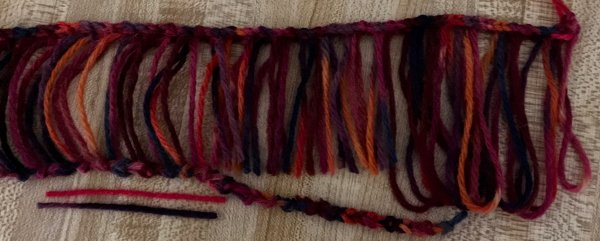
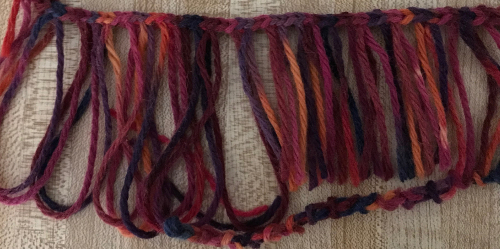
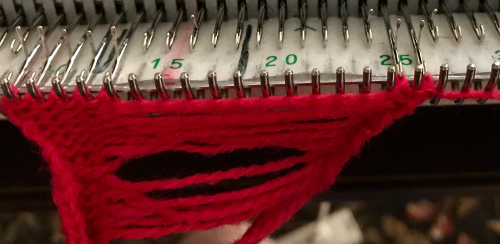
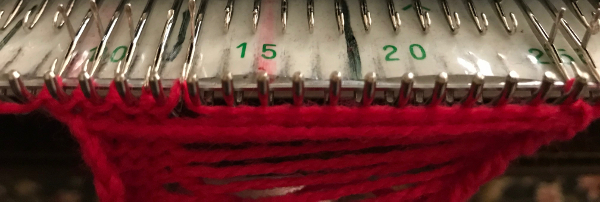
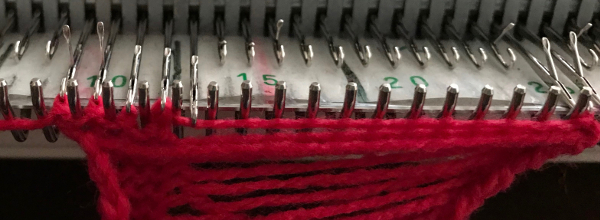 At the top of the piece, I transferred and doubled up the stitches on left, bound them off, and the yarn end(s) can be woven back into the cord.
At the top of the piece, I transferred and doubled up the stitches on left, bound them off, and the yarn end(s) can be woven back into the cord. 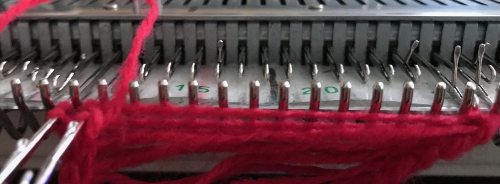 The side with the transfers is the “public” one, the finished fringe is usually hand sewn on, but it may also be used to cast on or be applied to several places in the knit both close together or at various intervals. Tension changes may be observed viewing from left to right, as well as the difference in length of loops as opposed to after the cutaway edge. The third stitch in work on the right may make for a more stable cutting line if looser tensions are preferred. Because the sinker plate used on the single bed has brushes and wheels in use, the width of the fringe can be considerable, without having to be concerned about stabilizing the center as it is when working on the double bed.
The side with the transfers is the “public” one, the finished fringe is usually hand sewn on, but it may also be used to cast on or be applied to several places in the knit both close together or at various intervals. Tension changes may be observed viewing from left to right, as well as the difference in length of loops as opposed to after the cutaway edge. The third stitch in work on the right may make for a more stable cutting line if looser tensions are preferred. Because the sinker plate used on the single bed has brushes and wheels in use, the width of the fringe can be considerable, without having to be concerned about stabilizing the center as it is when working on the double bed.
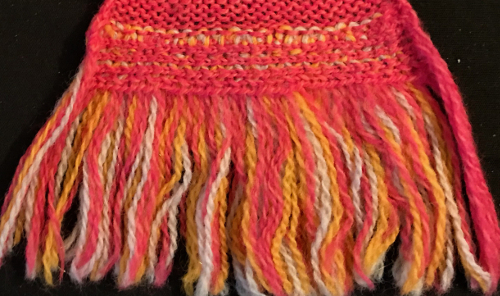
 Long loops are best in a thicker yarn, here they are shown in an every other needle arrangement using mohair on 2/8 wool ground
Long loops are best in a thicker yarn, here they are shown in an every other needle arrangement using mohair on 2/8 wool ground

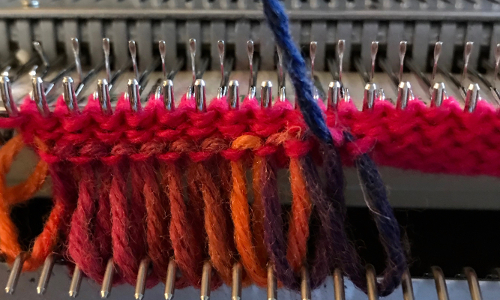
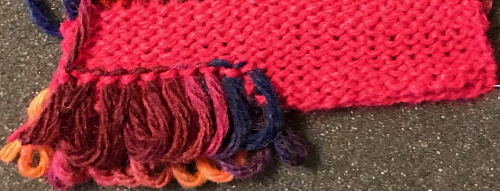 With ribber in the down most position (4.5 cm loops)
With ribber in the down most position (4.5 cm loops)

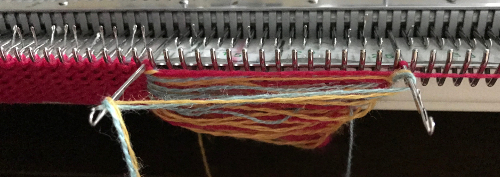
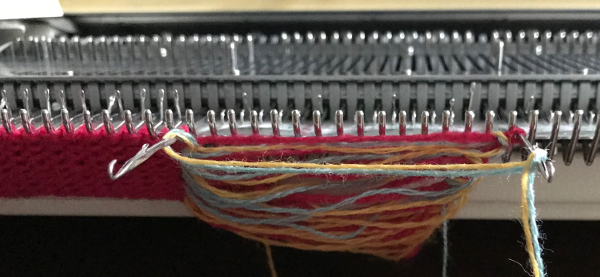 In this case, knitting ended opposite the fringe, only these stitches were bound off, not the single one on the far right
In this case, knitting ended opposite the fringe, only these stitches were bound off, not the single one on the far right 
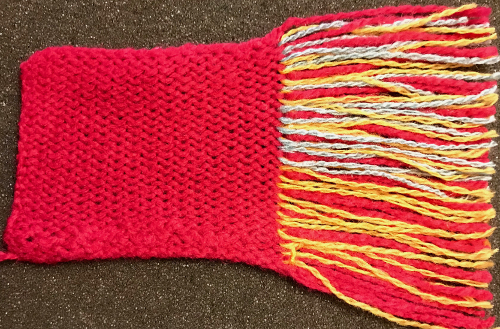
 Cut lengths of yarn may be added to edge or in the body of the knit, eyelets could be used as markers or for an all-over fabric, guiding placement. This illustration is from
Cut lengths of yarn may be added to edge or in the body of the knit, eyelets could be used as markers or for an all-over fabric, guiding placement. This illustration is from  Fringes could also be crocheted or hand-knit, used to cast on the piece or be stitched in place upon its completion. I do not have the source for this, will credit it if I can find one
Fringes could also be crocheted or hand-knit, used to cast on the piece or be stitched in place upon its completion. I do not have the source for this, will credit it if I can find one 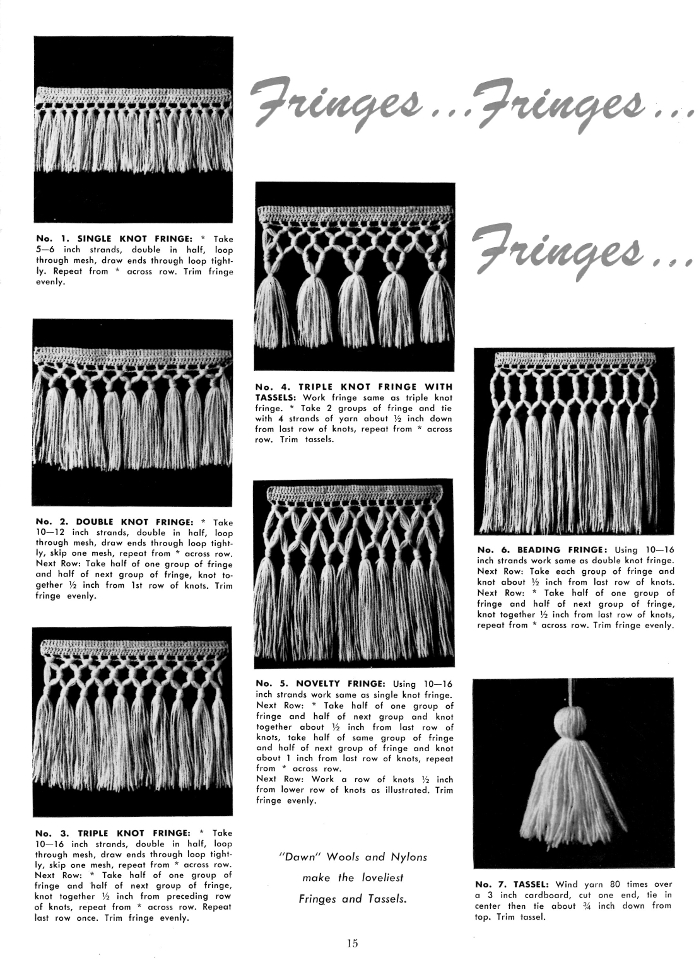
 I asked on Ravelry for advice or shared experiences. A possible culprit was suggested to me, and I was pointed toward the
I asked on Ravelry for advice or shared experiences. A possible culprit was suggested to me, and I was pointed toward the When I tried to turn the screws marked in red I found they were loose. After I took apart the racking handle, braving far more disassembly than turned out to be needed, housing little screws and washers in separate small plastic containers along with their comrade larger parts, I found perhaps I could have reduced the effort considerably. I did not take photos during the process, as I was not brimming with confidence in the result. Enlarging a portion of the above helped me understand how parts related to each other a bit better.
When I tried to turn the screws marked in red I found they were loose. After I took apart the racking handle, braving far more disassembly than turned out to be needed, housing little screws and washers in separate small plastic containers along with their comrade larger parts, I found perhaps I could have reduced the effort considerably. I did not take photos during the process, as I was not brimming with confidence in the result. Enlarging a portion of the above helped me understand how parts related to each other a bit better. 

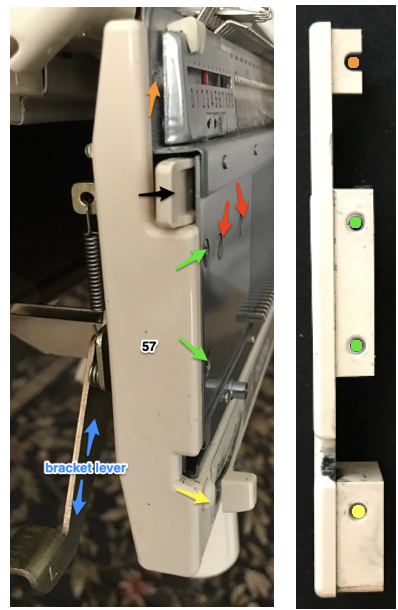
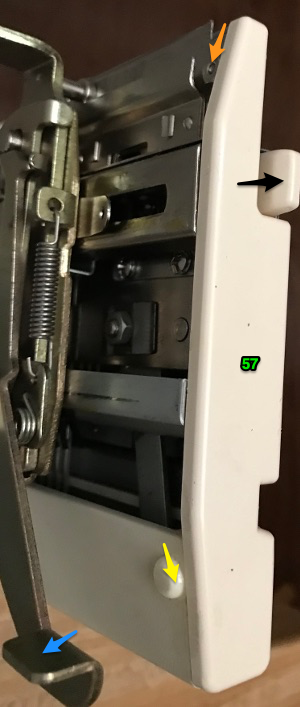 It really may not have been necessary to even remove the bracket lever. The #10 piece of metal was loose inside the machine, might simply have fallen out if I had turned the bed on its side and given it a mild shake after removing #57. This is with the piece in question in its housing where it belongs (white arrow), shown in relation to the needle retainer bar (black arrow) and screws marked with red arrows that hold it in place.
It really may not have been necessary to even remove the bracket lever. The #10 piece of metal was loose inside the machine, might simply have fallen out if I had turned the bed on its side and given it a mild shake after removing #57. This is with the piece in question in its housing where it belongs (white arrow), shown in relation to the needle retainer bar (black arrow) and screws marked with red arrows that hold it in place. 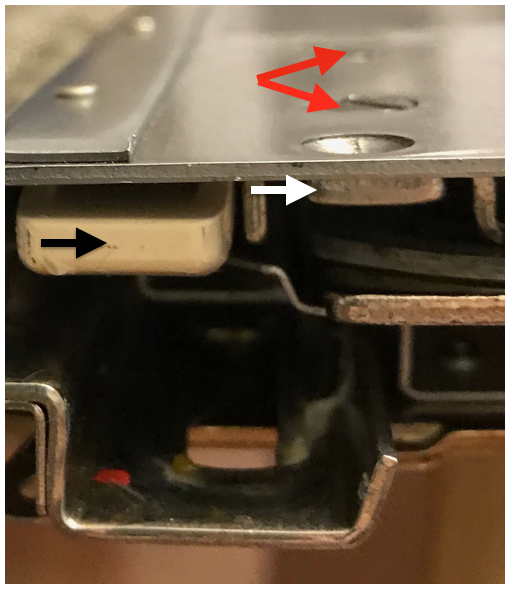 The piece is obviously thinner than the space it lives in, so for screws to anchor it properly, a flathead screwdriver or other improvised tool needs to be inserted under it, lifting it into position and holding it in place with its holes lined up with outside of bed so screws can grip it and be tightened properly.
The piece is obviously thinner than the space it lives in, so for screws to anchor it properly, a flathead screwdriver or other improvised tool needs to be inserted under it, lifting it into position and holding it in place with its holes lined up with outside of bed so screws can grip it and be tightened properly. 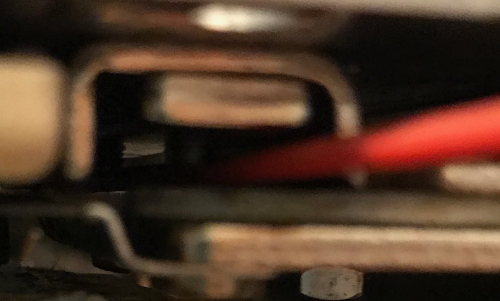
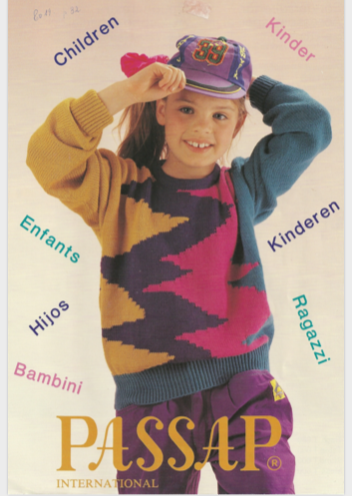 shown below on the right
shown below on the right 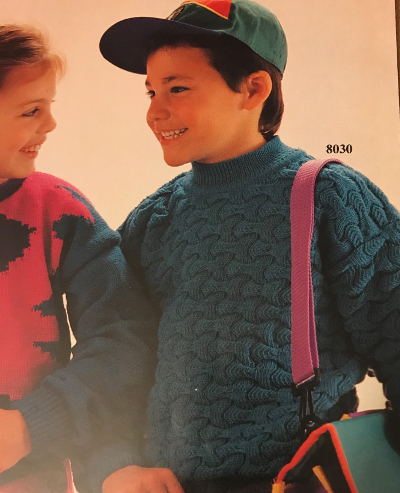
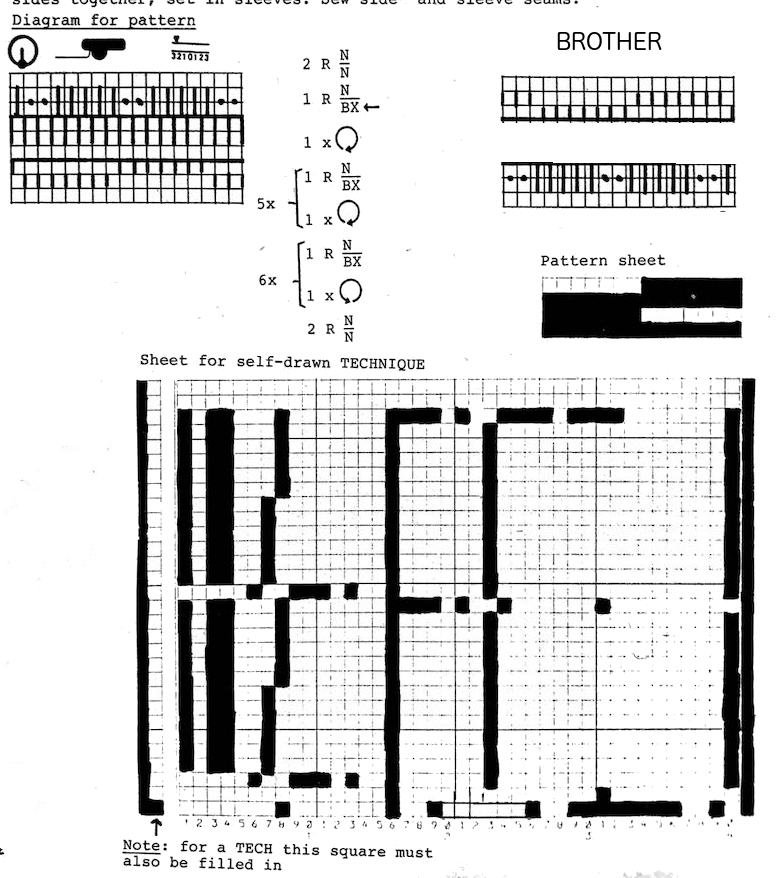 Translating Duo directions to black and white squares in order to develop a repeat for use on Brother: N/N is easy. The Duo is using buttons on the front bed and selection in response to their arrow setting to alter and progress through the pattern. The setup is with 7 needles up, 7 down, creating a 14 stitch repeat. BX on Duo (LX with patterning on front bed E6) is the equivalent of slip setting on Brother. No arrow keys, Passap on N, everything knits. Brother equivalent is a row of black squares (or punched holes if applicable) for each row on the N/N knit setting. BX <– will reverse the needle selection from whatever it was immediately before the previous rows of N/N, and remain there for the full racking sequence. After the first 32-row repeat is completed, at the end of the 12 racked rows, there will then be 4 all knit rows between racking sequences, two knit rows at the top would match 2 rows knit at the start. Once again, the BX<-for one row sets up the alternate blocks of racking. I chose to start my repeat with the 930 with a cast on in racking position 10. The chart shows racking positions on each row, reversing direction after having reached #4. E6 knitters may use the same repeat, matching the Duo racking starting on 3 left to 3 right and back
Translating Duo directions to black and white squares in order to develop a repeat for use on Brother: N/N is easy. The Duo is using buttons on the front bed and selection in response to their arrow setting to alter and progress through the pattern. The setup is with 7 needles up, 7 down, creating a 14 stitch repeat. BX on Duo (LX with patterning on front bed E6) is the equivalent of slip setting on Brother. No arrow keys, Passap on N, everything knits. Brother equivalent is a row of black squares (or punched holes if applicable) for each row on the N/N knit setting. BX <– will reverse the needle selection from whatever it was immediately before the previous rows of N/N, and remain there for the full racking sequence. After the first 32-row repeat is completed, at the end of the 12 racked rows, there will then be 4 all knit rows between racking sequences, two knit rows at the top would match 2 rows knit at the start. Once again, the BX<-for one row sets up the alternate blocks of racking. I chose to start my repeat with the 930 with a cast on in racking position 10. The chart shows racking positions on each row, reversing direction after having reached #4. E6 knitters may use the same repeat, matching the Duo racking starting on 3 left to 3 right and back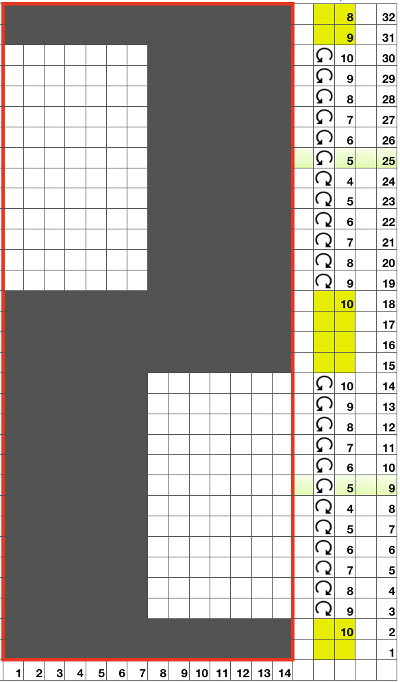 The repeat viewed tiled:
The repeat viewed tiled: 

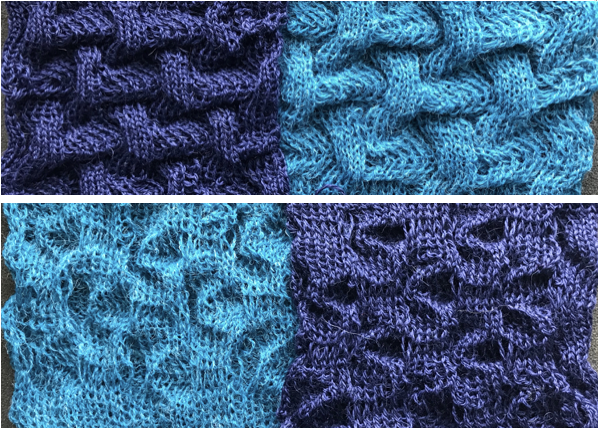 After swapping out the needle retainer bar, knitting went smoothly. On the right in the photos below, the same racking sequences and needles out of work on the ribber are used, but the knit carriage was not set to slip, so essentially, every stitch on every row on the top bed was being knit. In addition to needle preselection, one should also check the type of stitches actually being formed. One of the disadvantages to knitting ribber fabrics is that several inches may be produced before one can actually evaluate the pattern being knit by peeking between the beds.
After swapping out the needle retainer bar, knitting went smoothly. On the right in the photos below, the same racking sequences and needles out of work on the ribber are used, but the knit carriage was not set to slip, so essentially, every stitch on every row on the top bed was being knit. In addition to needle preselection, one should also check the type of stitches actually being formed. One of the disadvantages to knitting ribber fabrics is that several inches may be produced before one can actually evaluate the pattern being knit by peeking between the beds. 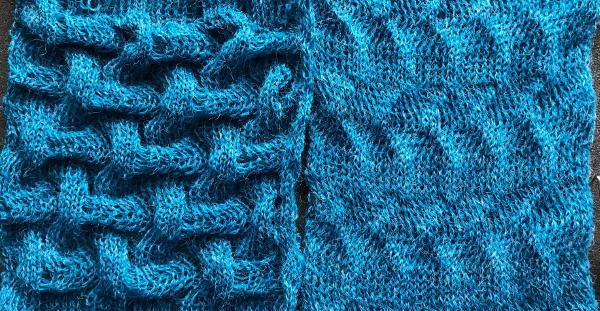
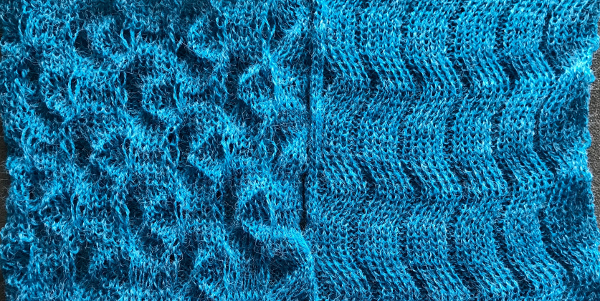 I will have to revisit a
I will have to revisit a 


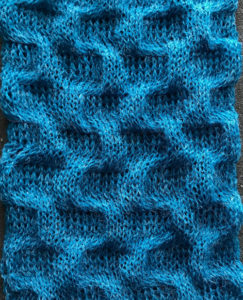

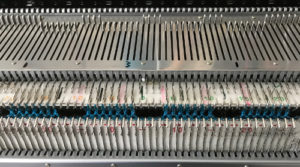 All needles used in my swatch, I began the stitch transfers down onto the ribber needles on the far left, continuing across the knit bed.
All needles used in my swatch, I began the stitch transfers down onto the ribber needles on the far left, continuing across the knit bed.  As end stitches knit on the ribber alone, a small edge weight may be required on that side. As stitches on the main bed are not worked in the slip stitch rows, they become elongated. Racking by 4 positions is not possible unless there is enough fabric so as not to pull so much that stitches will not knit off. If the yarn does not have some “give” that can make the changes in position harder, some yarns may break easily. The long stitches:
As end stitches knit on the ribber alone, a small edge weight may be required on that side. As stitches on the main bed are not worked in the slip stitch rows, they become elongated. Racking by 4 positions is not possible unless there is enough fabric so as not to pull so much that stitches will not knit off. If the yarn does not have some “give” that can make the changes in position harder, some yarns may break easily. The long stitches: 

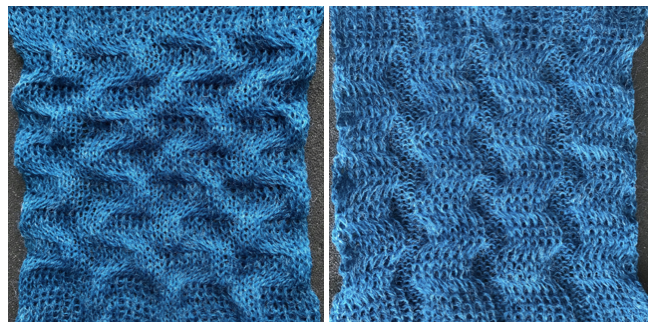
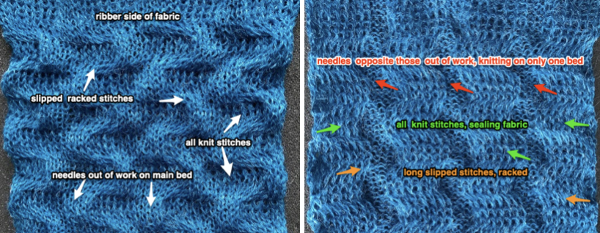 This is the swatch knit changing ribber settings to and from slip <– –> to N/N on appropriate rows. I found the method above far simpler
This is the swatch knit changing ribber settings to and from slip <– –> to N/N on appropriate rows. I found the method above far simpler 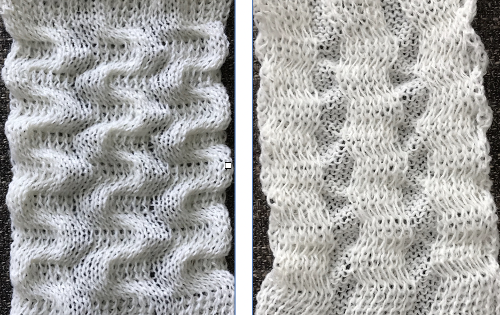 Coincidentally this morning a Duo pattern using a different setup was shown in Ravelry, and I was asked whether producing the same on Brother might have any advantages. The Duo results, shown on a
Coincidentally this morning a Duo pattern using a different setup was shown in Ravelry, and I was asked whether producing the same on Brother might have any advantages. The Duo results, shown on a 
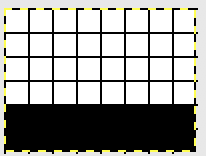 Racking is from position 10 to 6 and back just as in the previous blue swatch, after the first preselection row at the start of the following repeat sequence. I began the stitch transfers down onto the ribber needles on the far left, continuing across the knit bed. The final look will vary with the choice of yarn and its color. Both swatch sides.
Racking is from position 10 to 6 and back just as in the previous blue swatch, after the first preselection row at the start of the following repeat sequence. I began the stitch transfers down onto the ribber needles on the far left, continuing across the knit bed. The final look will vary with the choice of yarn and its color. Both swatch sides.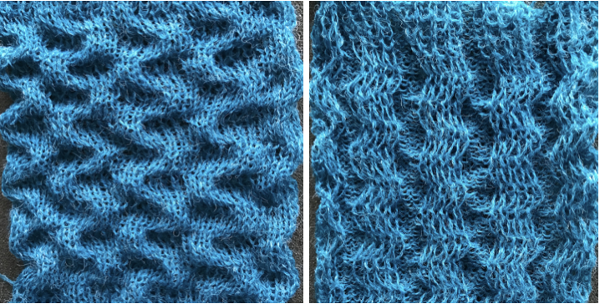 If for some reason horizontal direction matters simply cast on with racking position on 6, and continue to and from there to 10 and back. Below is a horizontal flip of the same swatch image, a way to quickly decide whether doing so might be preferred.
If for some reason horizontal direction matters simply cast on with racking position on 6, and continue to and from there to 10 and back. Below is a horizontal flip of the same swatch image, a way to quickly decide whether doing so might be preferred.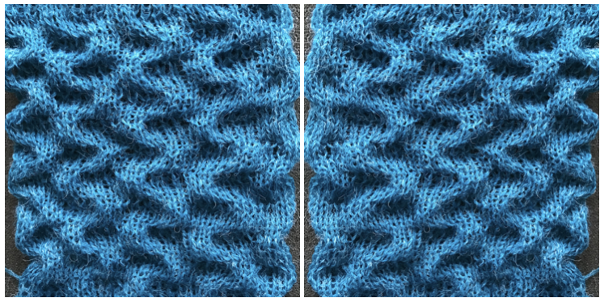
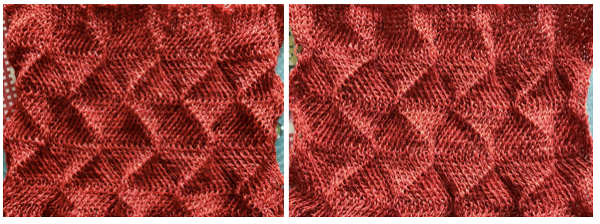 The only way to find out is to try it. The lesson already learned: use a crisp yarn that can retain memory for maximum effect. Here, the swatch is knit in a 3/14 cotton. To start with, racking was from position 0 to 6 and back. Racking every 2 rows at the bottom of the sample, every row at its top
The only way to find out is to try it. The lesson already learned: use a crisp yarn that can retain memory for maximum effect. Here, the swatch is knit in a 3/14 cotton. To start with, racking was from position 0 to 6 and back. Racking every 2 rows at the bottom of the sample, every row at its top Now adding needles out of work with the expectation of folds at approximate center of each fold
Now adding needles out of work with the expectation of folds at approximate center of each fold Racking started in center position 0, then swung to 3 left, to 3 right, ending on 0. I long ago got frustrated with the Passap numbering, marked the racking positions with a permanent marker from 0 on the right to 6 on the left. The knit result is a rolling fabric, though a bit less so than the Brother sample, which was able to move across more racking positions.
Racking started in center position 0, then swung to 3 left, to 3 right, ending on 0. I long ago got frustrated with the Passap numbering, marked the racking positions with a permanent marker from 0 on the right to 6 on the left. The knit result is a rolling fabric, though a bit less so than the Brother sample, which was able to move across more racking positions. 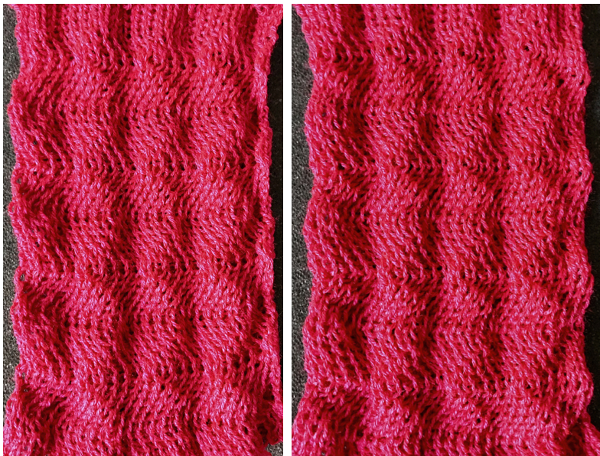


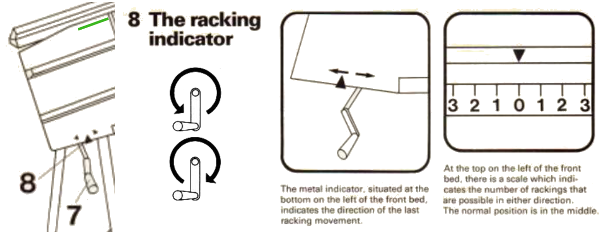 The Passap E6 manual shows racking patterns possible with console built-in designs on pp. 118, 119, 120, 121, with techniques used in racking patterns number 257-272. The console gives prompts for the direction in racking sequences. Self-programmed designs would need a separate knitting technique entered into the console as an additional “design”. This can be done with a card reader combined with a pattern download from a computer. Programs that automate the function are no longer on the market. Typically, in published patterns for either brand, if the starting point for the racking sequence is important, it will be given along with the frequency of movements such as in this design from the Duo 80 book
The Passap E6 manual shows racking patterns possible with console built-in designs on pp. 118, 119, 120, 121, with techniques used in racking patterns number 257-272. The console gives prompts for the direction in racking sequences. Self-programmed designs would need a separate knitting technique entered into the console as an additional “design”. This can be done with a card reader combined with a pattern download from a computer. Programs that automate the function are no longer on the market. Typically, in published patterns for either brand, if the starting point for the racking sequence is important, it will be given along with the frequency of movements such as in this design from the Duo 80 book
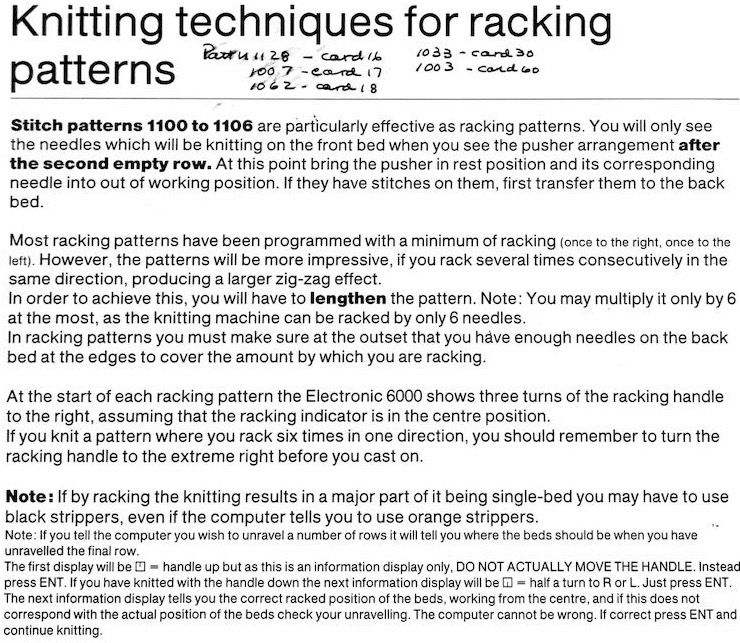


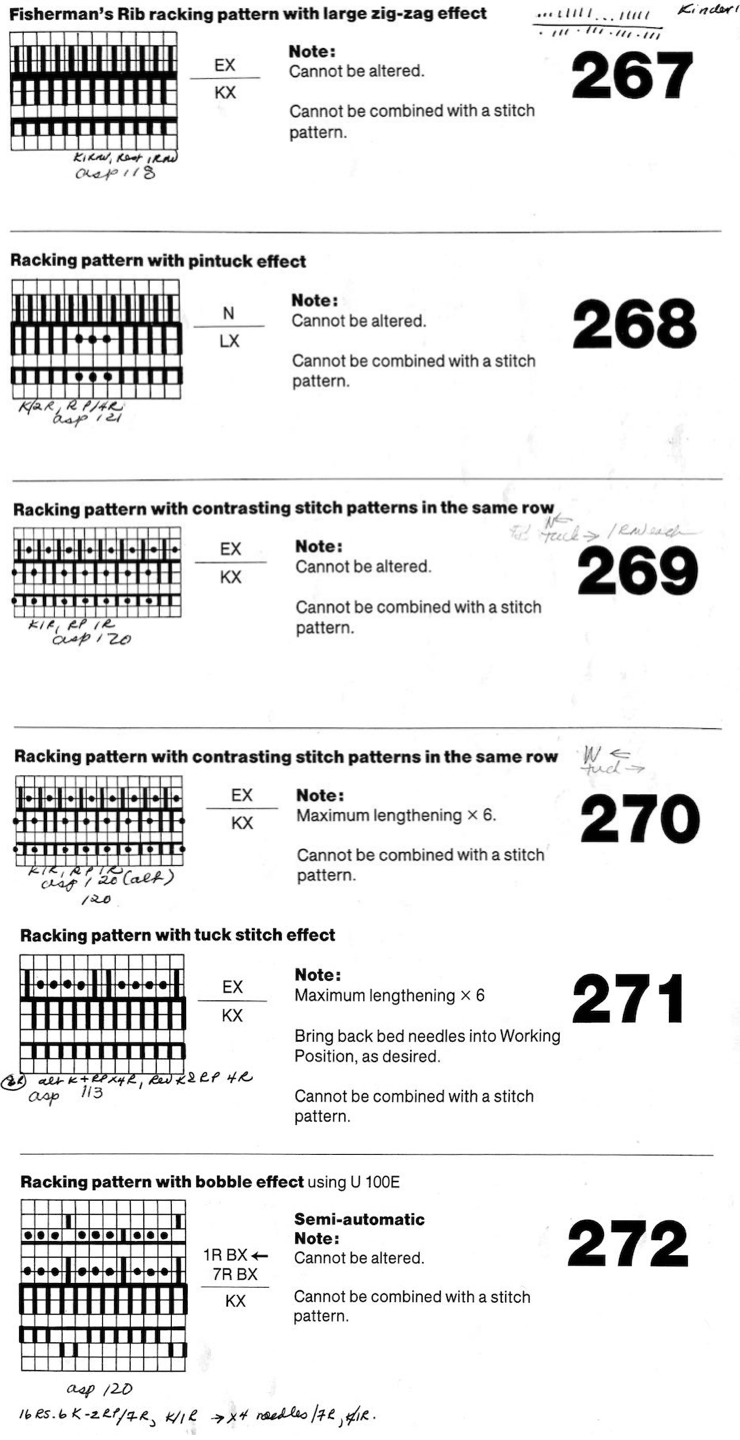
 Some Duo symbols and their meaning
Some Duo symbols and their meaning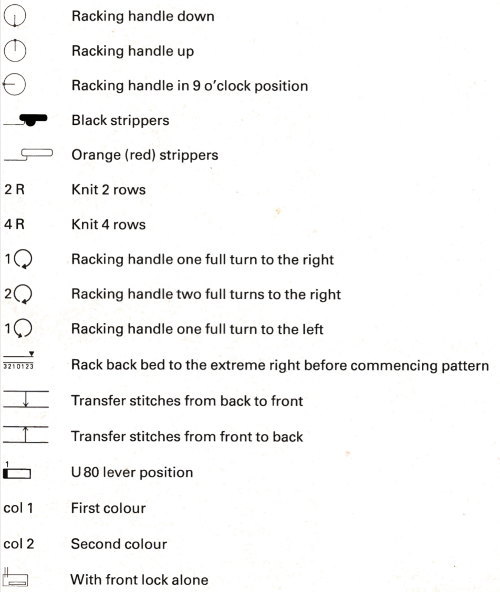
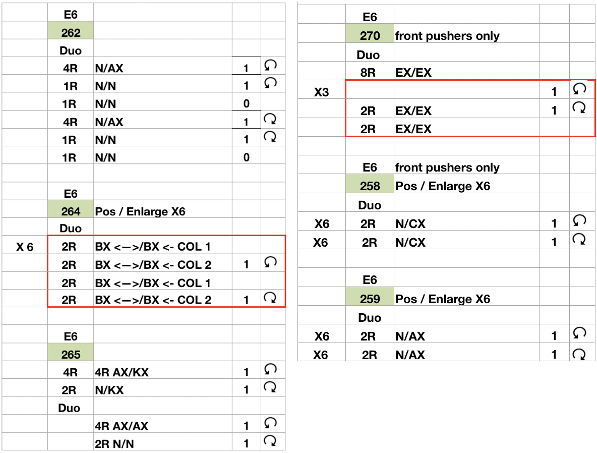

 My sample was knit in a tightly twisted cotton, and when off the machine had an interesting and unexpected fold 3Dquality
My sample was knit in a tightly twisted cotton, and when off the machine had an interesting and unexpected fold 3Dquality 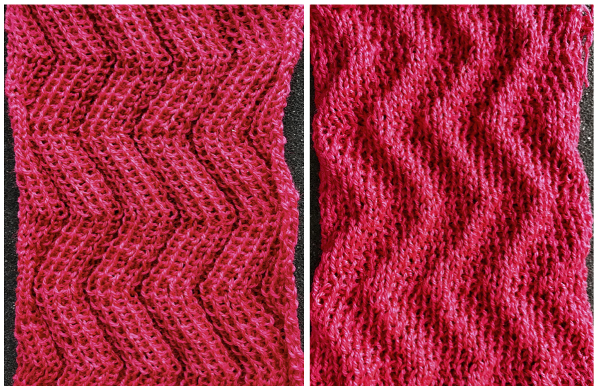

 The setup is essentially the same, with white squares representing needles and pushers that need to be out of work. Tech 258 uses LX (slip) on the front bed, back bed si set to N. The duomatic pattern has a different OOW needle arrangement, the front lock is also set to tuck = FX (E6=KX), adding another layer of texture and complexity. Needles are also out of work on the back bed.
The setup is essentially the same, with white squares representing needles and pushers that need to be out of work. Tech 258 uses LX (slip) on the front bed, back bed si set to N. The duomatic pattern has a different OOW needle arrangement, the front lock is also set to tuck = FX (E6=KX), adding another layer of texture and complexity. Needles are also out of work on the back bed.
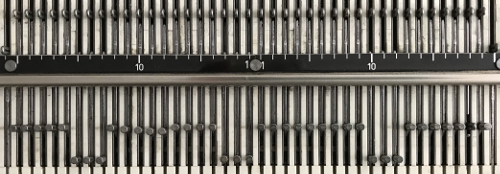 What is knitting in terms of black and white squares if one continues:
What is knitting in terms of black and white squares if one continues: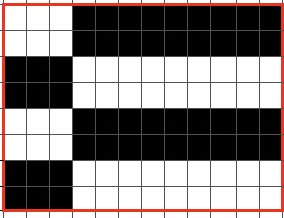
 this repeat is what is required to match the technique diagram
this repeat is what is required to match the technique diagram


 Below the pattern alternates blocks of 5 black squares, 5 white, color changing every 2 rows and reversing racking direction after every 24 rows. The full repeat is 48 rows. If rows knit in the zig-zag are counted, they amount to 12 because each color slips it is not knitting for 2 rows. Note that to achieve the color reversal at the halfway point of the repeat the same color (2) knits for 4 rows, at the top of the repeat color 1 does the same.
Below the pattern alternates blocks of 5 black squares, 5 white, color changing every 2 rows and reversing racking direction after every 24 rows. The full repeat is 48 rows. If rows knit in the zig-zag are counted, they amount to 12 because each color slips it is not knitting for 2 rows. Note that to achieve the color reversal at the halfway point of the repeat the same color (2) knits for 4 rows, at the top of the repeat color 1 does the same.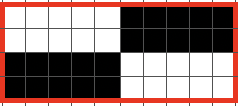
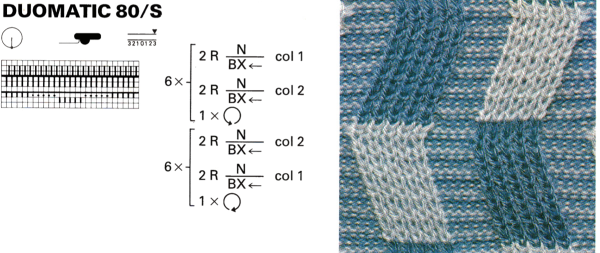

 Back to acrylic yarn, light color for more visibility, creative yarn snag on the left midway, full swing movement is shown, each is 48 rows in height. As always, it helps to check whether the stitches are obliging by staying on the needle bed. The top half of the swatch is pictured.
Back to acrylic yarn, light color for more visibility, creative yarn snag on the left midway, full swing movement is shown, each is 48 rows in height. As always, it helps to check whether the stitches are obliging by staying on the needle bed. The top half of the swatch is pictured. In turn, I programmed # 1000 X 6 in height, but the pusher selection was all up for one row, one down. I left it alone, and lastly, worked with pusher selection on the back bed, BX <–. Patterning advances a fixed repeat every row or every other, determined by original hand-selected up for selection and down above rail for out of selection. The front lock is left on N (disregard front for setting it to LX). There is a world of other possibilities, while the console racking sequences can be used from built-in techniques.
In turn, I programmed # 1000 X 6 in height, but the pusher selection was all up for one row, one down. I left it alone, and lastly, worked with pusher selection on the back bed, BX <–. Patterning advances a fixed repeat every row or every other, determined by original hand-selected up for selection and down above rail for out of selection. The front lock is left on N (disregard front for setting it to LX). There is a world of other possibilities, while the console racking sequences can be used from built-in techniques. 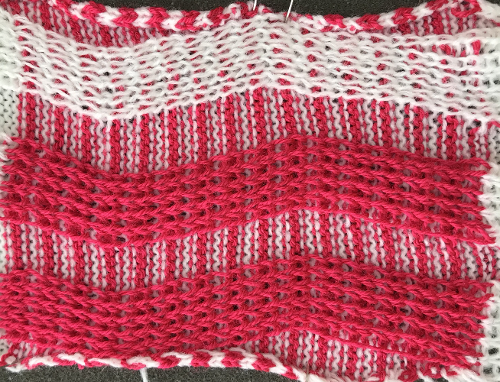 Any ribber needle selection on Brother other than with the use of lili buttons would have to be done manually.
Any ribber needle selection on Brother other than with the use of lili buttons would have to be done manually.